Beneath every beautifully curated living space lies a foundation, and in many homes that foundation is a dark brown floor—silky walnut, deep espresso, or near-black ebony planks that radiate character. When treated thoughtfully, that richness becomes a springboard for color, texture, and mood rather than a decorating hurdle. Recent design reports show homeowners gravitating toward layered lighting, balanced contrasts, and tactile finishes to make these floors shine, while timeless principles such as strategic color pairing and furniture scale remain as relevant as ever. Step into the following ideas to see how designers translate those principles into inviting, personality-packed living rooms.
1. Crisp White Walls Energize Dark Brown Floors
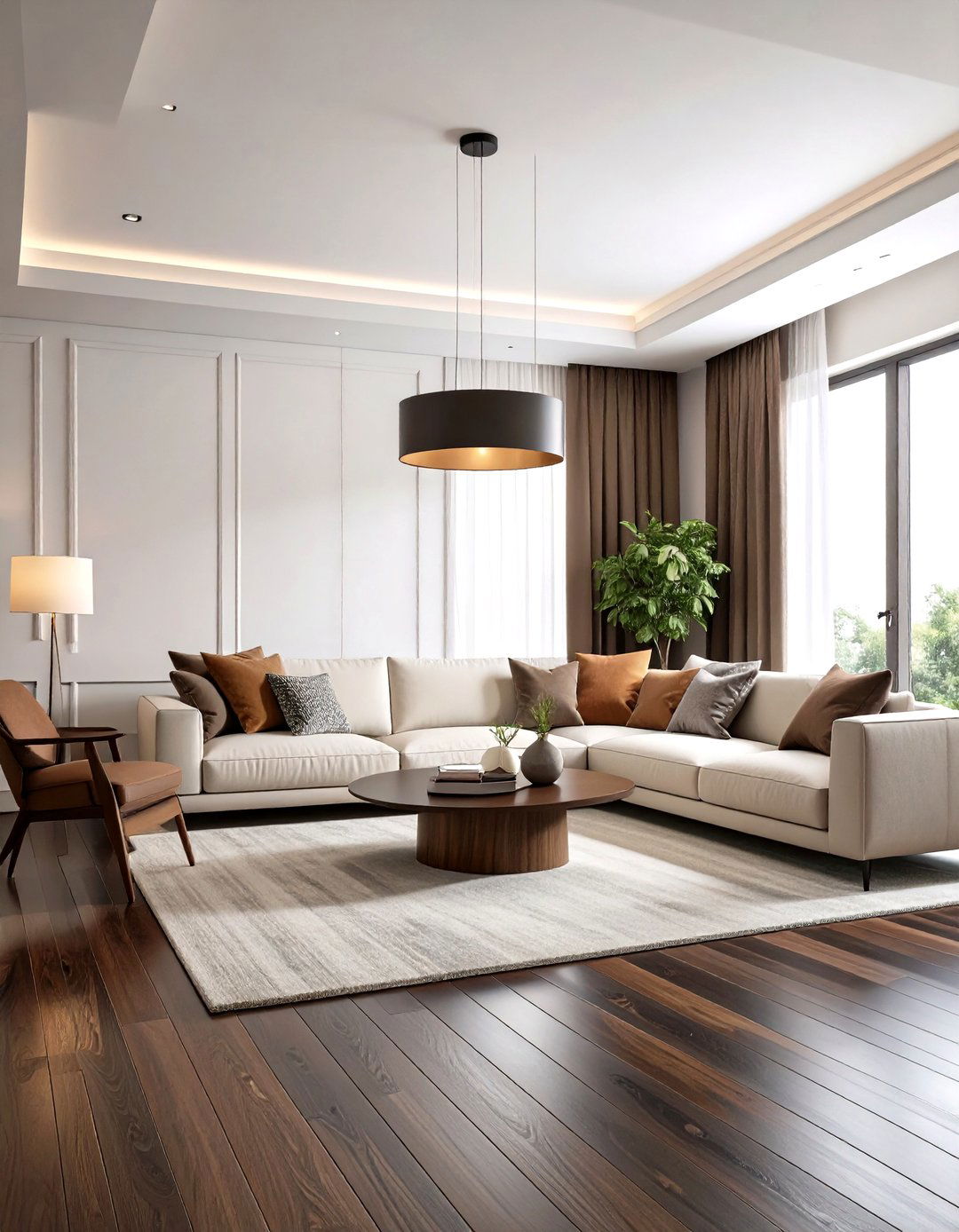
Painting the walls a bright, gallery-style white instantly lifts a living room anchored by a dark brown floor. The clean backdrop bounces both daylight and lamplight around the space, turning the chocolate planks into an elegant grounding feature instead of a visual weight. Crisp trim painted in the same tone erases distracting shadow lines, lengthening sightlines and making ceilings feel higher. Because white is neutral, you can rotate accent colors seasonally—think ochre cushions in autumn or citrus artwork in summer—without clashing with the flooring. If full-white feels stark, warm it with linen curtains or woven shades in sandy hues so the palette still feels cohesive.
2. Layer Sculptural Lighting for Drama and Comfort
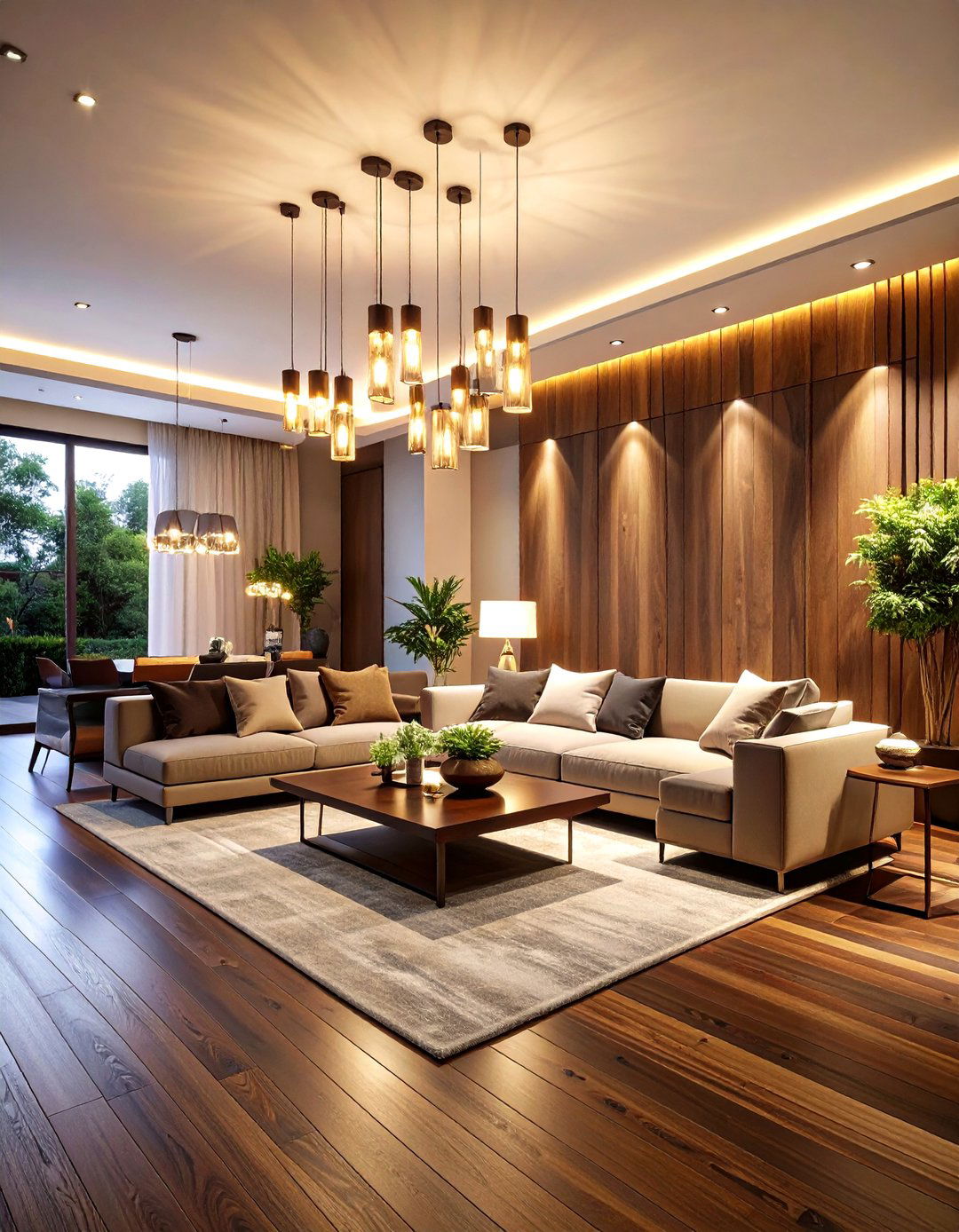
Statement fixtures are one of the biggest living-room upgrades predicted for 2025, with designers emphasizing layered schemes that pair architectural sconces, chandeliers, and sculptural floor lamps. Anchoring those light sources at different heights breaks up the dark brown floor’s expanse by creating vertical columns of glow, which makes the room feel taller at night. Perimeter rail or track lights aimed downward eliminate moody corners without the glare that a single overhead source can create. Finish the composition with dimmable LEDs so you can shift from bright family gatherings to soft movie-night ambiance while always letting the rich timber grain remain center stage.
3. Balance with Light-Toned, Airy Furniture Pieces
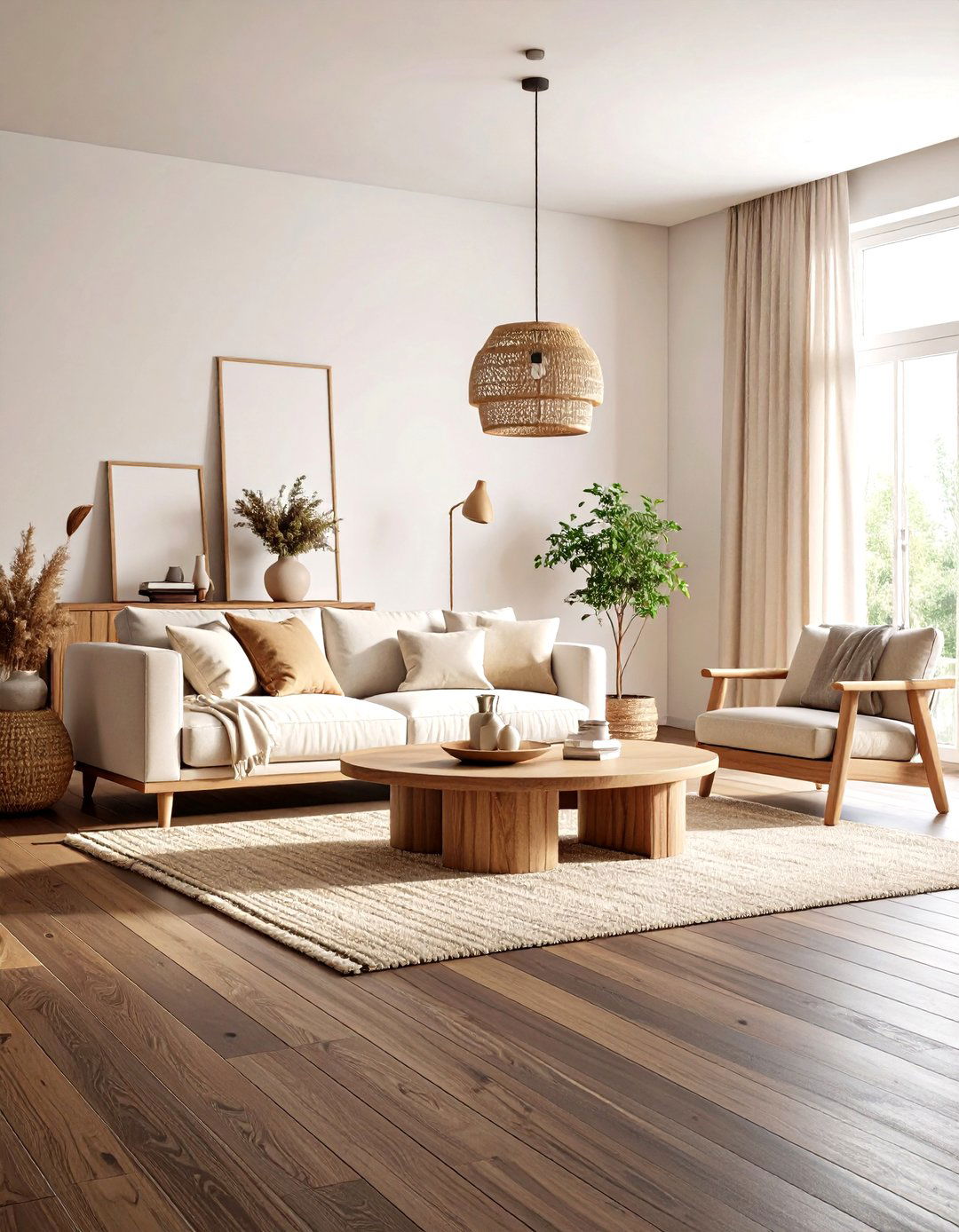
Light wood frames, pale oak coffee tables, and sofas in oatmeal linen provide the visual breathing room that dark brown floors crave. Designers note that contrasting tones prevent the room from feeling bottom-heavy and help important pieces stand out against the floor’s depth. To heighten the effect, pick furniture legs a few shades lighter than the planks so they appear to float. If you can’t resist a darker leather club chair, balance it by flanking with ivory side tables or installing a pale media console. This strategy also future-proofs the space, because lighter upholstery fabrics are easier to refresh with slipcovers or new cushions whenever tastes evolve.
4. Lay an Ivory or Cream Rug for Striking Contrast
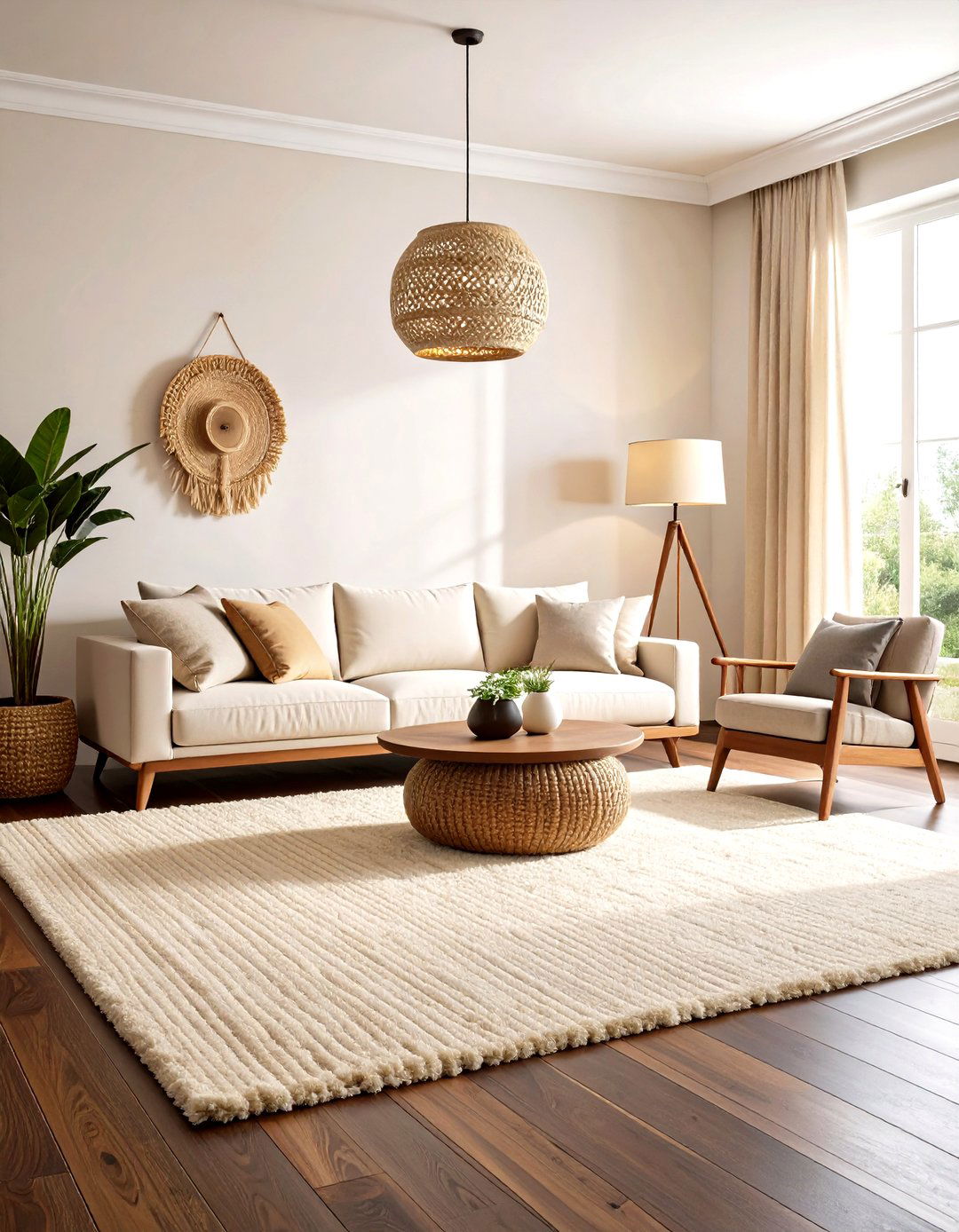
A generous area rug in soft ivory or cream delivers one of the highest impact-for-effort changes you can make on a dark brown floor. The high contrast instantly brightens the seating area, defines conversation zones, and adds acoustic softness. Look for muted patterns—tone-on-tone damask, faint chevrons, or subtle stripes—that introduce depth without stealing focus. Opt for thicker pile or a plush wool blend to counterbalance the floor’s hard surface and make bare-foot moments luxurious. Don’t forget a low-profile rug pad so the light rug stays sharp and flat; choosing corner grippers keeps edges crisp and avoids dangerous curls.
5. Surround the Space in Moody Jewel-Tone Paint
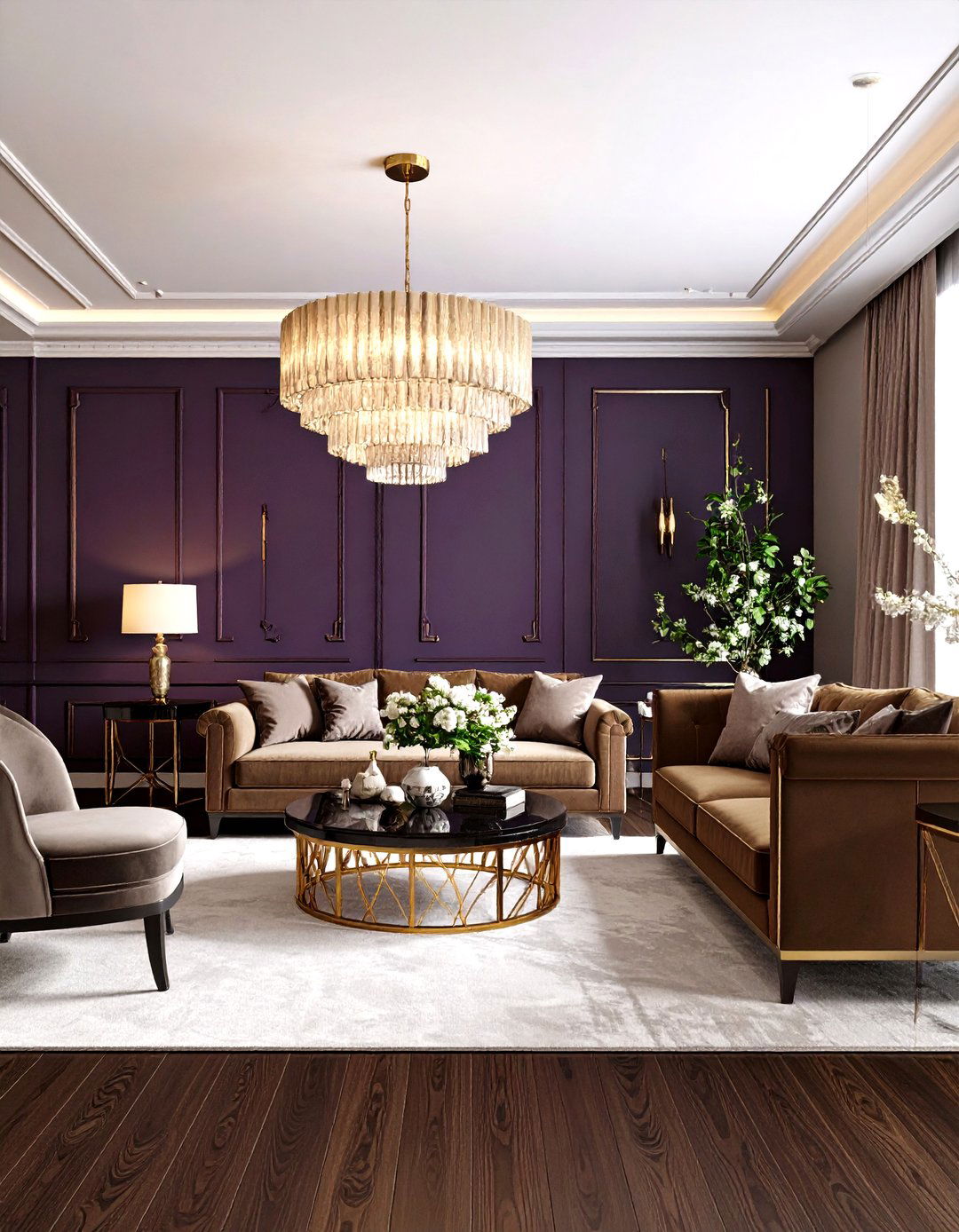
When you crave drama, cloak the walls in an inky sapphire, deep emerald, or velvety aubergine—shades trend forecasters predict will dominate moody interiors this year. Deep colors echo the warmth of dark brown floors, creating a cocoon that feels luxurious rather than oppressive. To keep the scheme sophisticated, select matte or eggshell finishes that absorb glare and let textures read clearly. Break the saturation with polished nickel hardware, white ceiling paint, or narrow picture-molding stripes painted two tones lighter. The result is an intimate living room that feels curated, personal, and perfect for evening entertaining beside flickering candles.
6. Introduce Earthy Green Accents for Organic Calm
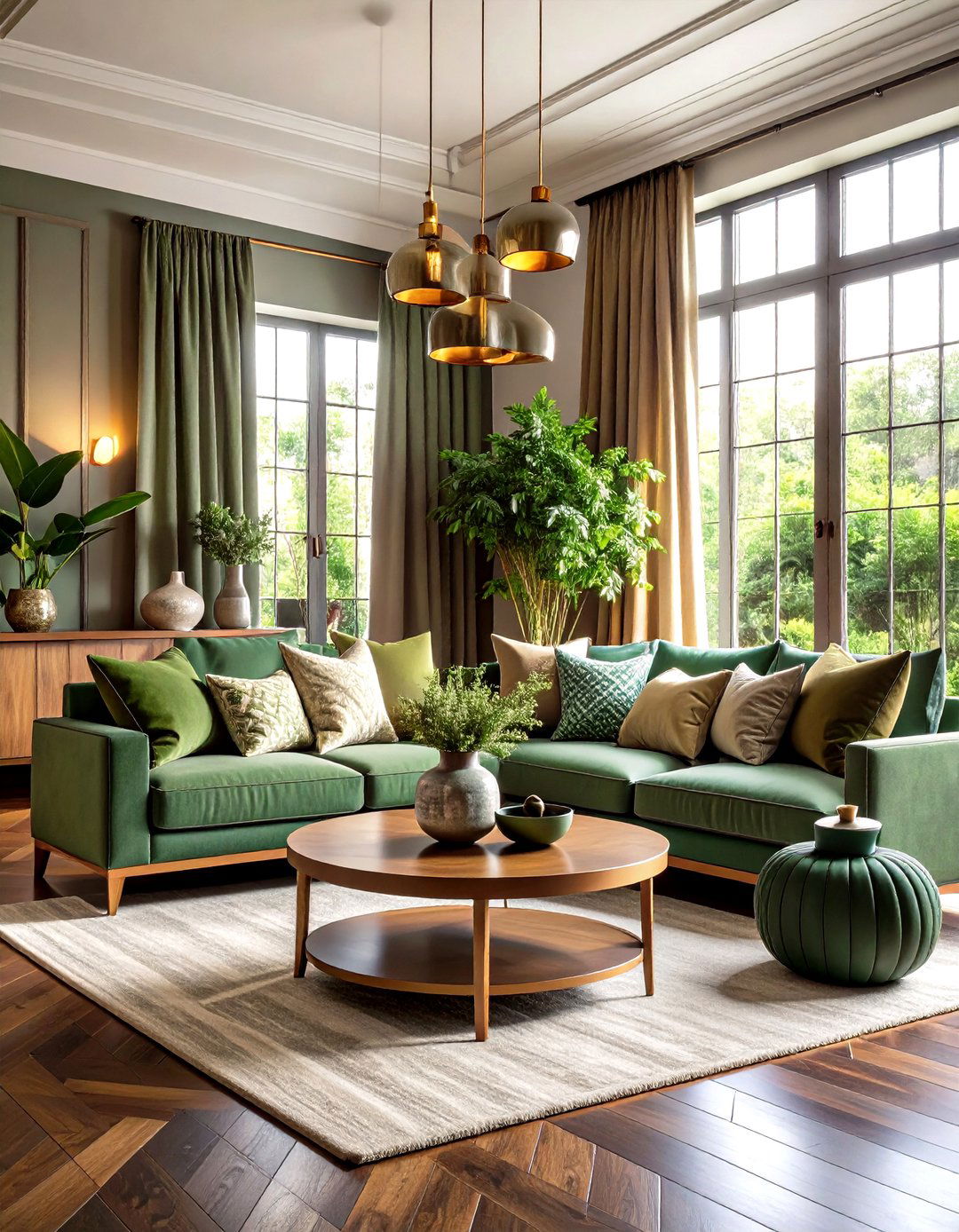
Earth-forward greens—sage, olive, and eucalyptus—bring a restorative vibe that pairs naturally with the brown undertones of dark wood flooring. Designers recommend starting small: a pair of moss-colored throw pillows, an accent chair upholstered in muted fern fabric, or ceramic planters glazed in celadon. Because green sits adjacent to brown on the color wheel, it complements rather than competes, allowing the grain pattern to remain the star. Layer live plants in varying heights to reiterate the palette and improve air quality. Finish with antique brass planter stands or woven jute baskets for additional texture that harmonizes the forest-inspired scheme.
7. Reflect Light with Warm Metallic Accents
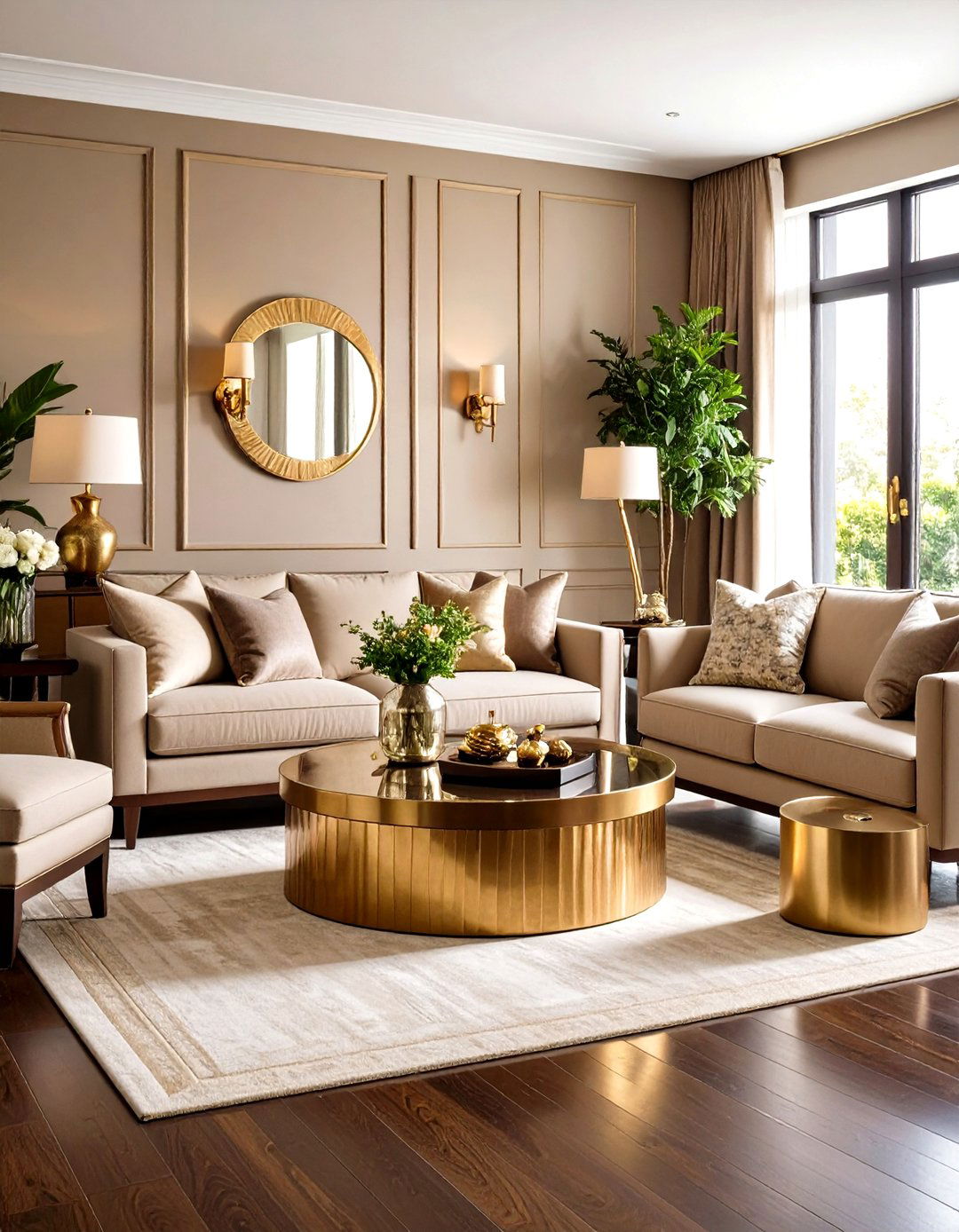
A small collection of warm metallic pieces—think burnished brass sconces, antiqued gold picture frames, or a hammered-bronze coffee-table tray—adds reflected light and instant sophistication to a room grounded by a dark brown floor. Metallic surfaces scatter highlights across the plank seams, subtly drawing attention to the floor’s texture while preventing the space from feeling flat. Keep the metal finishes consistent to avoid visual clutter; one brushed-gold tone repeated three times feels deliberate and elegant. If you’re wary of committing to hardware swaps, start with a sculptural table lamp or candlesticks and evaluate how the glow elevates evening gatherings.
8. Layer Plush Textiles for Cozy Dimension
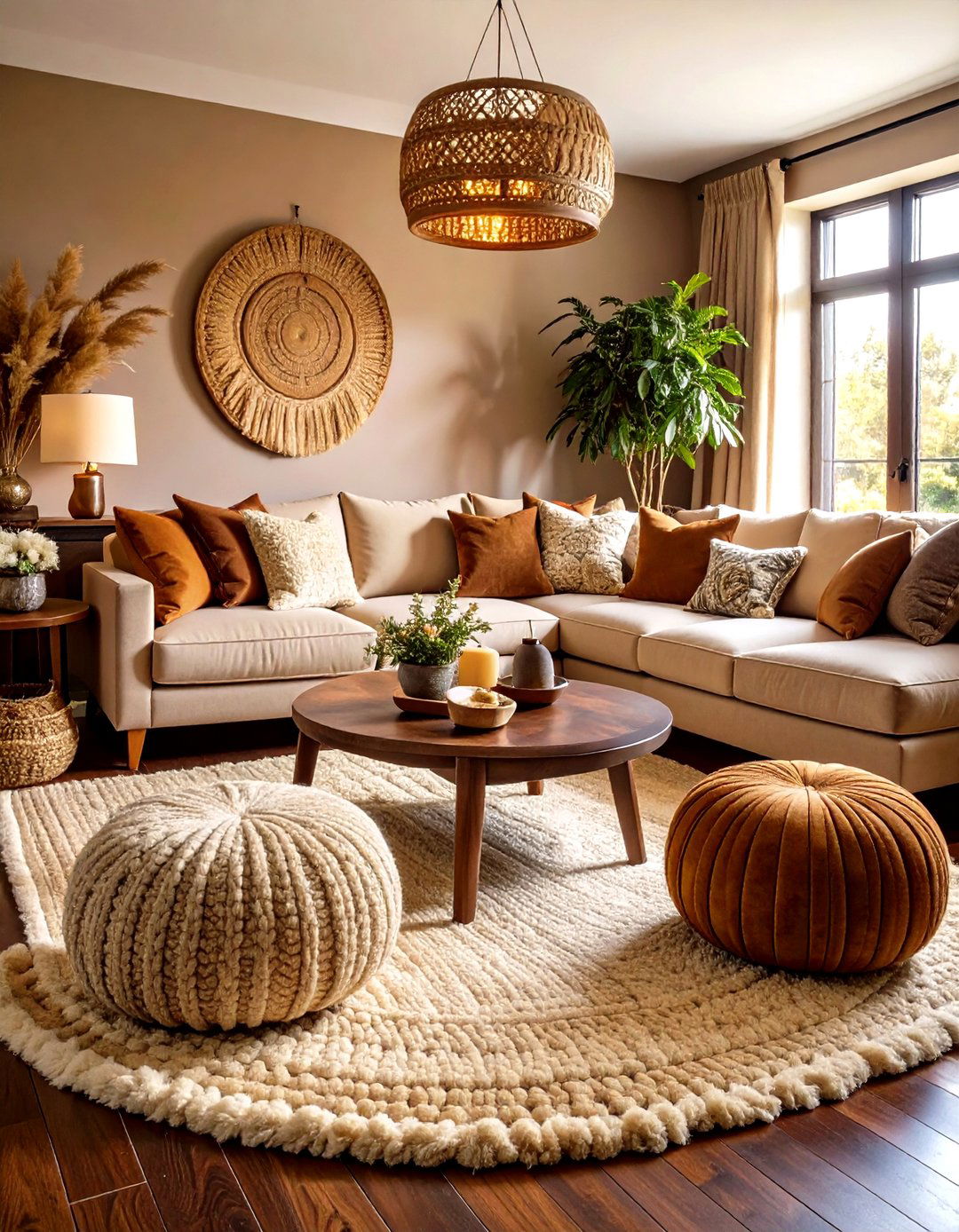
Texture is the secret weapon against the potential heaviness of dark flooring, and layering multiple fabrics instantly softens the room. Designers recommend combining velvet cushions, boucle throws, and nubby wool poufs so light dances across different surfaces while remaining cohesive. Vary pile heights and choose a tight palette—charcoal, ivory, and camel, for instance—to maintain harmony. During cooler months, consider a faux-fur throw casually draped over a pale armchair; in summer, swap for breathable linen covers to keep the look fresh. The tactile approach invites touch, encourages relaxation, and offsets the visual weight of the brown timber below.
9. Embrace Curved Seating and Organic Silhouettes

Curved sofas, rounded coffee tables, and serpentine benches are rising stars in living-room design, bringing fluid energy that counteracts the rigid lines of hardwood planks. The sinuous forms create natural conversation pits and highlight the warm, swirling grain of a dark brown floor by contrast. Position a curved sofa on a light rug so its shape reads clearly, and let a circular chandelier echo the motif overhead. If investment pieces aren’t feasible, experiment with rounded ottomans or arc-back accent chairs to capture the trend's embrace without overhauling existing furniture. Organic contours make every step felt and every seat inviting.
10. Weave in Wicker or Rattan for Casual Warmth
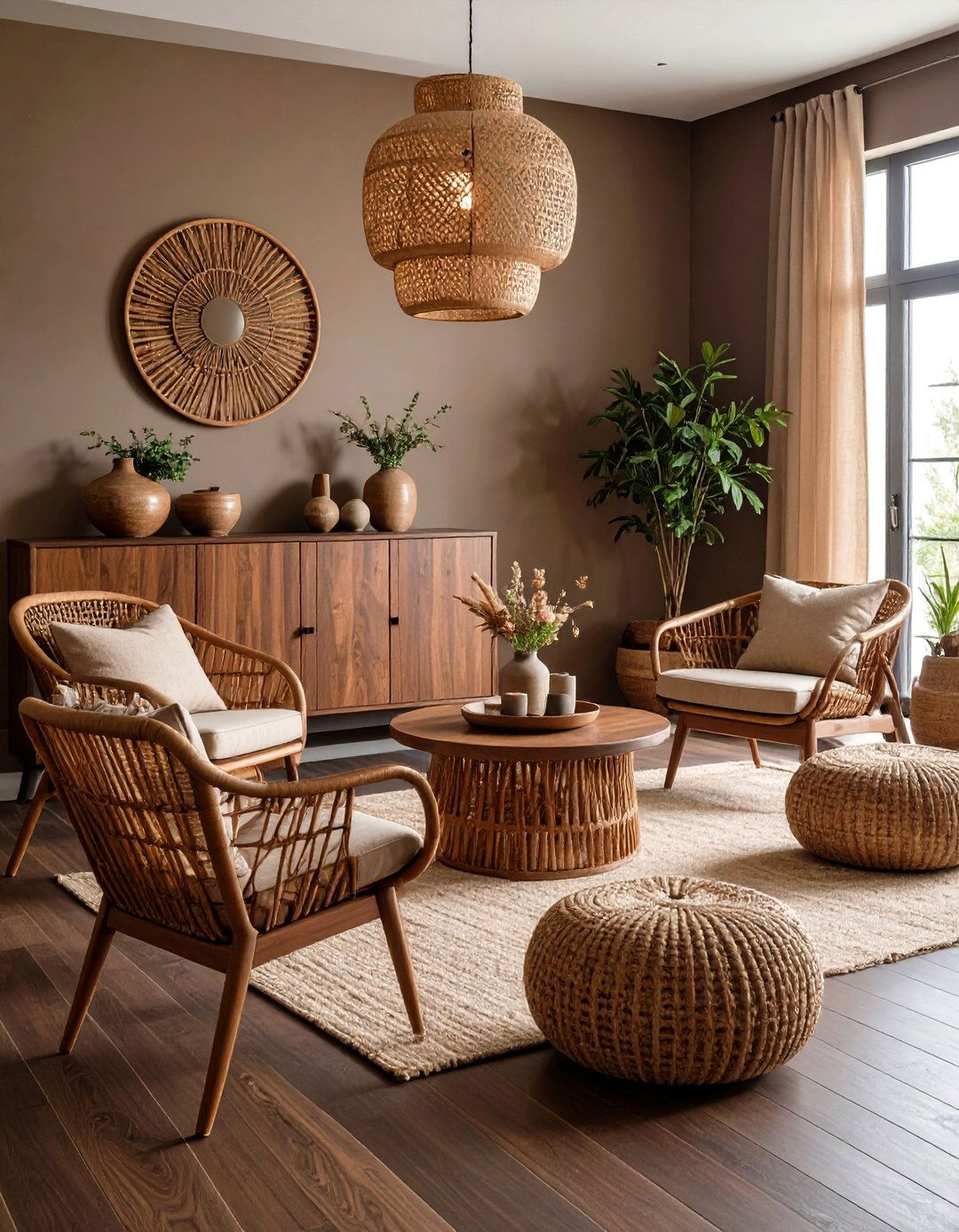
Natural fiber furniture peeks—woven wicker side chairs, a rattan-wrapped console, or a cane-front media cabinet—lend breezy charm that tempers the formality often associated with dark brown floors. Their tactile weave introduces shadow play and a sun-kissed hue, helping the floor feel part of a relaxed, approachable palette. Blend wicker with richer materials—such as a marble-top side table or velvet cushions—to strike balance between coastal casual and polished city living. A clear matte sealant keeps the fibers fresh and dust-resistant, ensuring the pieces remain functional as well as beautiful.
11. Double Down with a Dark-on-Dark Monochrome Scheme
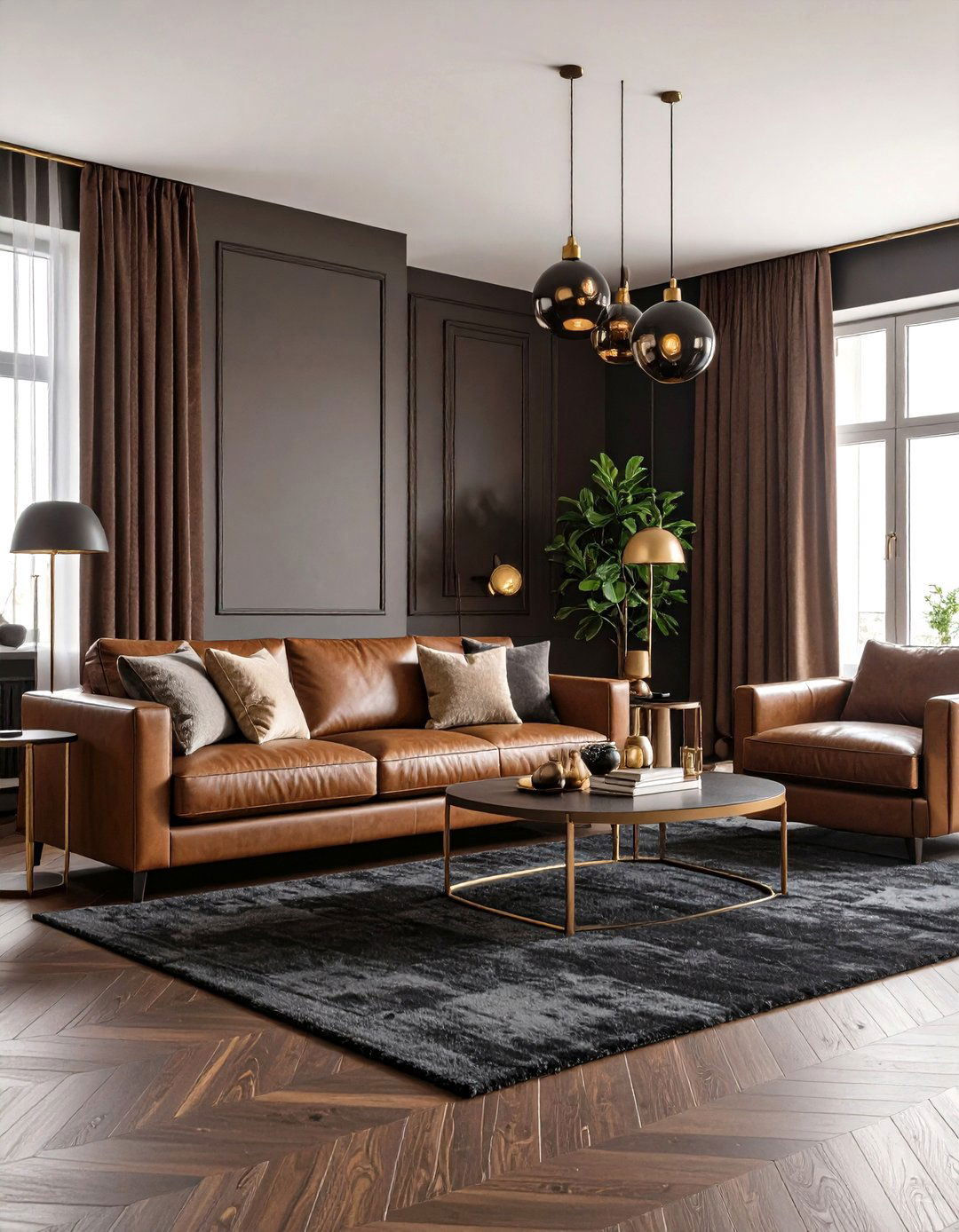
Going tone-on-tone intensifies the floor’s sophistication: layer a charcoal wool rug over espresso planks, bring in umber slipcovers, and scatter midnight blue throws for nuanced depth. The secret is variety—mixing matte, distressed, and subtly glossy finishes prevents the palette from becoming visually flat. Introduce a few brass or smoked-glass accents so light has surfaces to bounce off, and keep walls a half-step lighter (think warm pewter) to define edges. The result is a sultry, lounge-like living room that makes movie nights or late-night conversations feel cinematic.
12. Use Oversize Artwork to Draw the Eye Upward

Large-scale art—whether an expressive canvas, a photographic diptych, or a contemporary tapestry—pulls visual attention skyward, ensuring the dark brown floor reads as intentional grounding rather than an anchor. Center the piece above the sofa and install adjustable picture lights so evening illumination highlights both art and the plank sheen below. Choose frames that echo floor tones for cohesion or select minimalist white edges for crisp contrast. Oversize pieces also reduce the number of small accessories needed, keeping the room tidy and letting the flooring breathe.
13. Amplify Daylight with Strategically Placed Mirrors
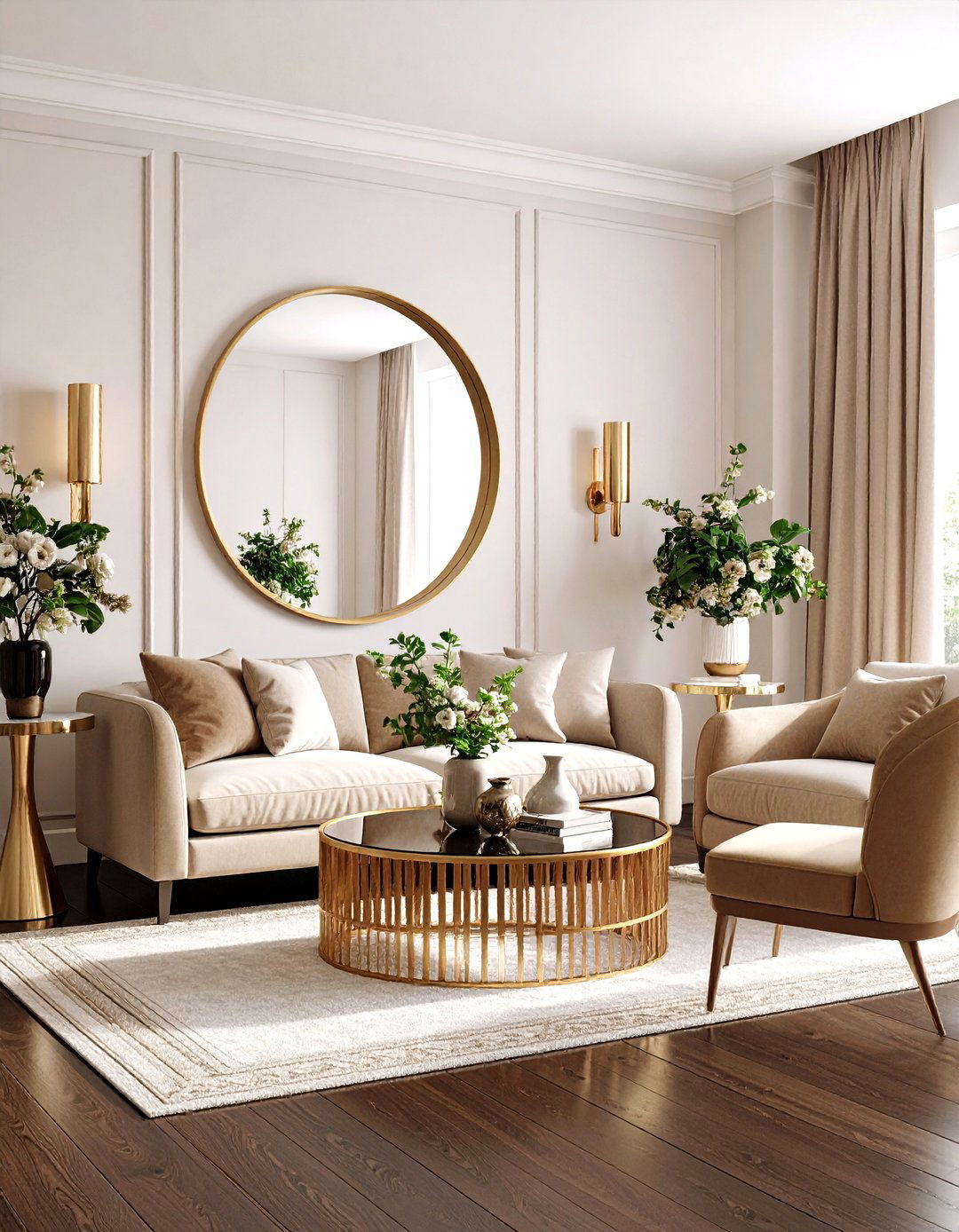
Mirrors remain a timeless tactic for bouncing daylight deeper into the room, particularly helpful when dark flooring absorbs light. Hang a generous mirror opposite the largest window to double the incoming rays, then flank it with slender sconces to create evening sparkle. A mirrored coffee table or metallic tray can echo the effect at ground level, reflecting subtle highlights across the boards. Keep frames slim and finish them to match nearby hardware for a cohesive, upscale look that feels considered rather than decorative afterthought.
14. Zone Open-Plan Areas with Layered Rugs
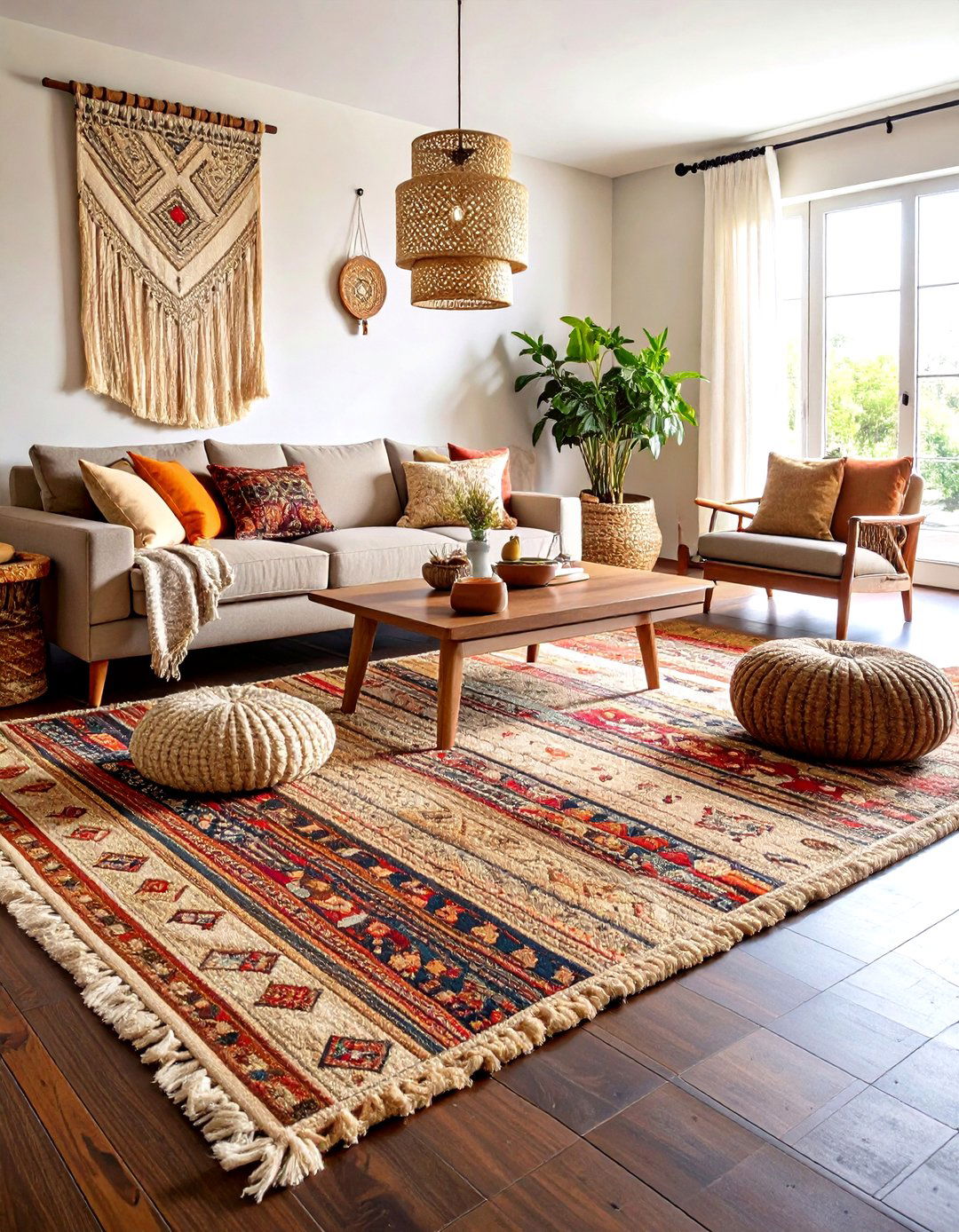
In an open-plan layout, dark brown floors can visually blur functional areas. Designers recommend laying multiple rugs—one under the seating cluster, another beneath a reading nook—to carve clear zones without erecting physical barriers. Vary rug sizes but stick to a unifying palette so the eye flows easily. A jute base layer topped with a patterned kilim adds both texture and flexibility: remove the accent rug for a simplified summer look, then reintroduce it when you crave warmth. The layered approach also protects high-traffic pathways while letting the beautiful wood grain peek through around the borders.
15. Install Built-In Shelving in Harmonizing Wood Tones
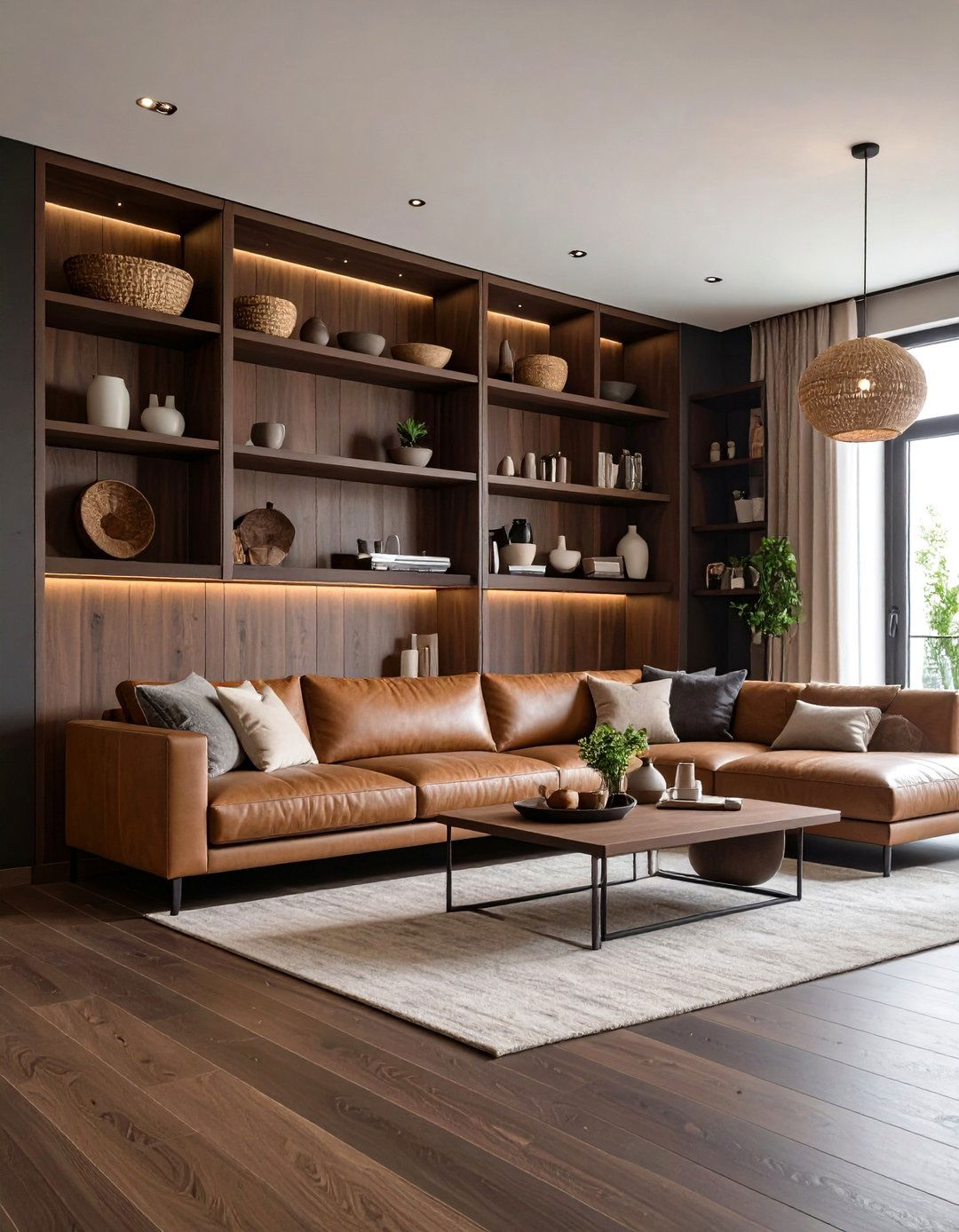
Custom built-ins painted or stained to echo the dark brown floor create an enveloping, bespoke feel while delivering much-needed storage. By matching the undertone—warm red-brown or cooler espresso—you create an architectural envelope that feels intentional, not pieced together. Break the expanse with a few lighter shelves or concealed LED strips to keep the wall from reading monolithic. Display neutral ceramics, woven baskets, and layered books so the shelving tells a curated story rather than becoming visual clutter.
16. Channel Modern Cottagecore with Warm Patterns
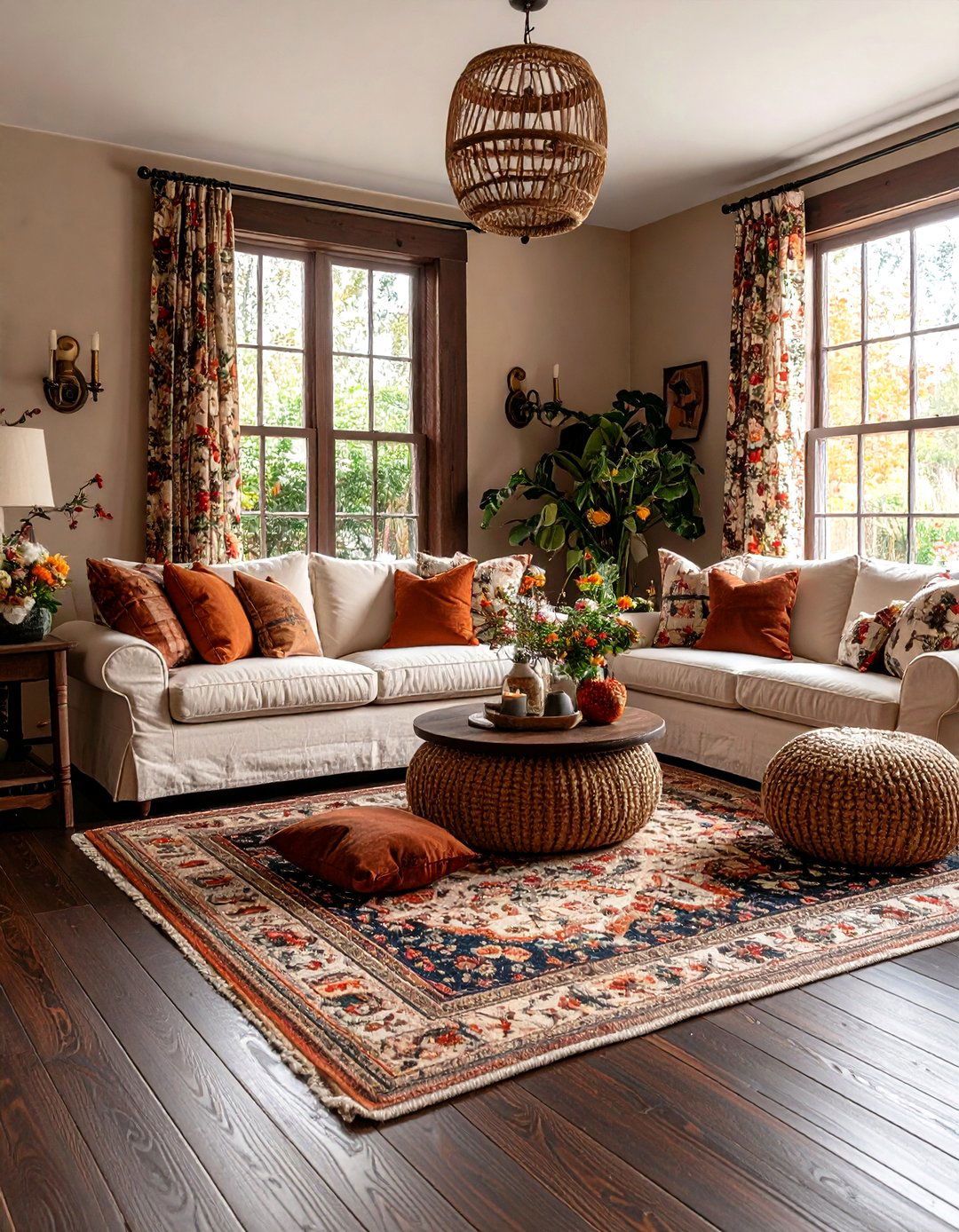
The updated cottage look pairs classic florals and ginghams with tailored upholstery, offering a charming counterpoint to dark brown floors. Designers predict the trend will lean on artisanal materials and sustainable craftsmanship throughout 2025, bringing soulful warmth to everyday living spaces. Think a slipcovered sofa in linen-blend gingham, vintage brass sconces, and an heirloom-style braided rug—elements that soften the floor’s strength without hiding it. Finish with hand-thrown pottery and softly patterned drapery for lived-in authenticity.
17. Follow the 60-30-10 Rule for Effortless Balance
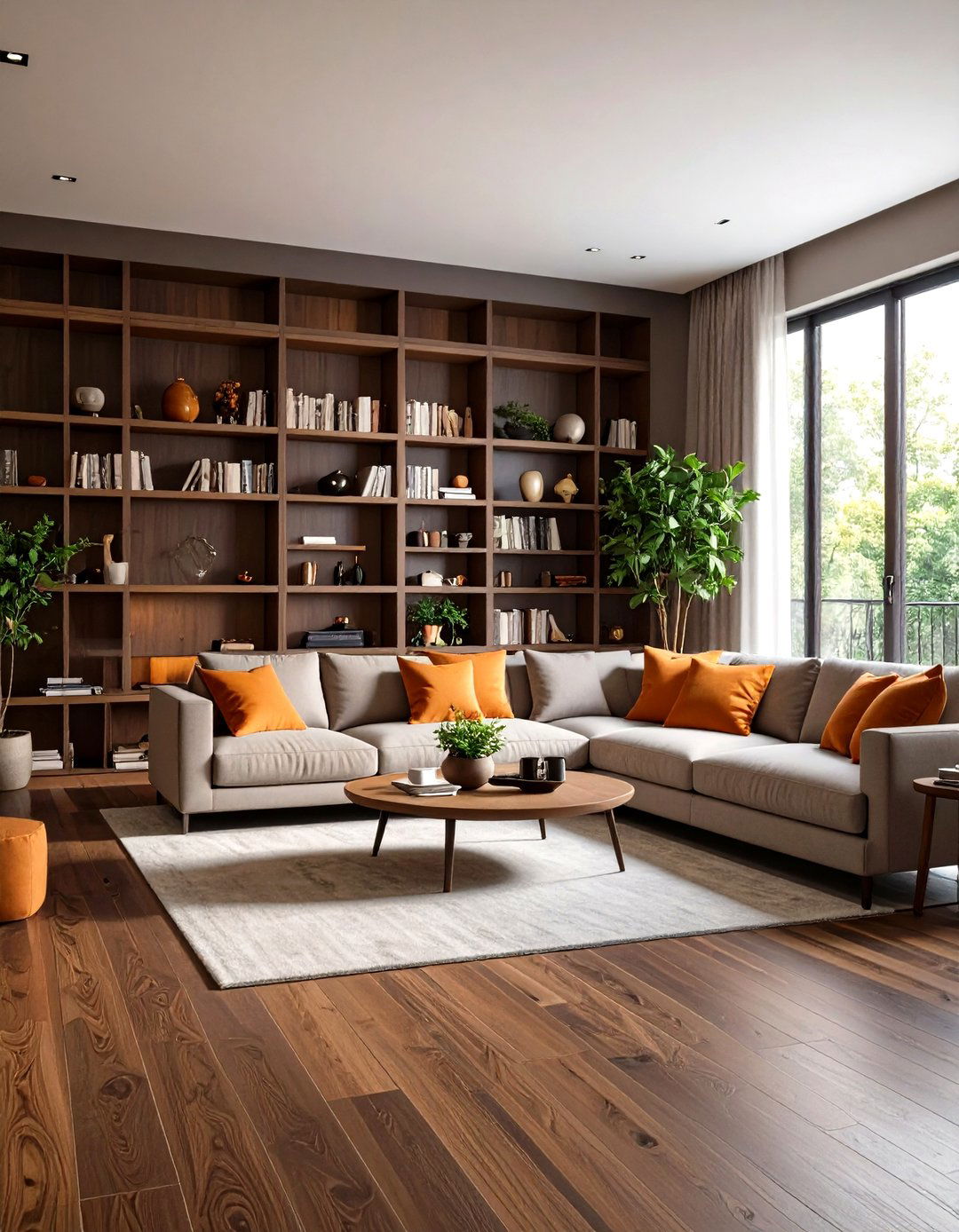
Color proportion matters just as much as hue. Stylists suggest treating the dark brown floor as either the 60-percent dominant element or the 30-percent secondary tone, then choosing wall color and accent shades accordingly. For example, let the floor and a coordinating bookcase handle 60 percent, a pale gray sofa represent 30 percent, and burnt-orange pillows claim the final 10. This deliberate distribution maintains harmony, prevents overpowering darkness, and simplifies future accessory swaps because each piece has a clear role in the palette hierarchy.
18. Bring in Natural Textures and Living Greenery
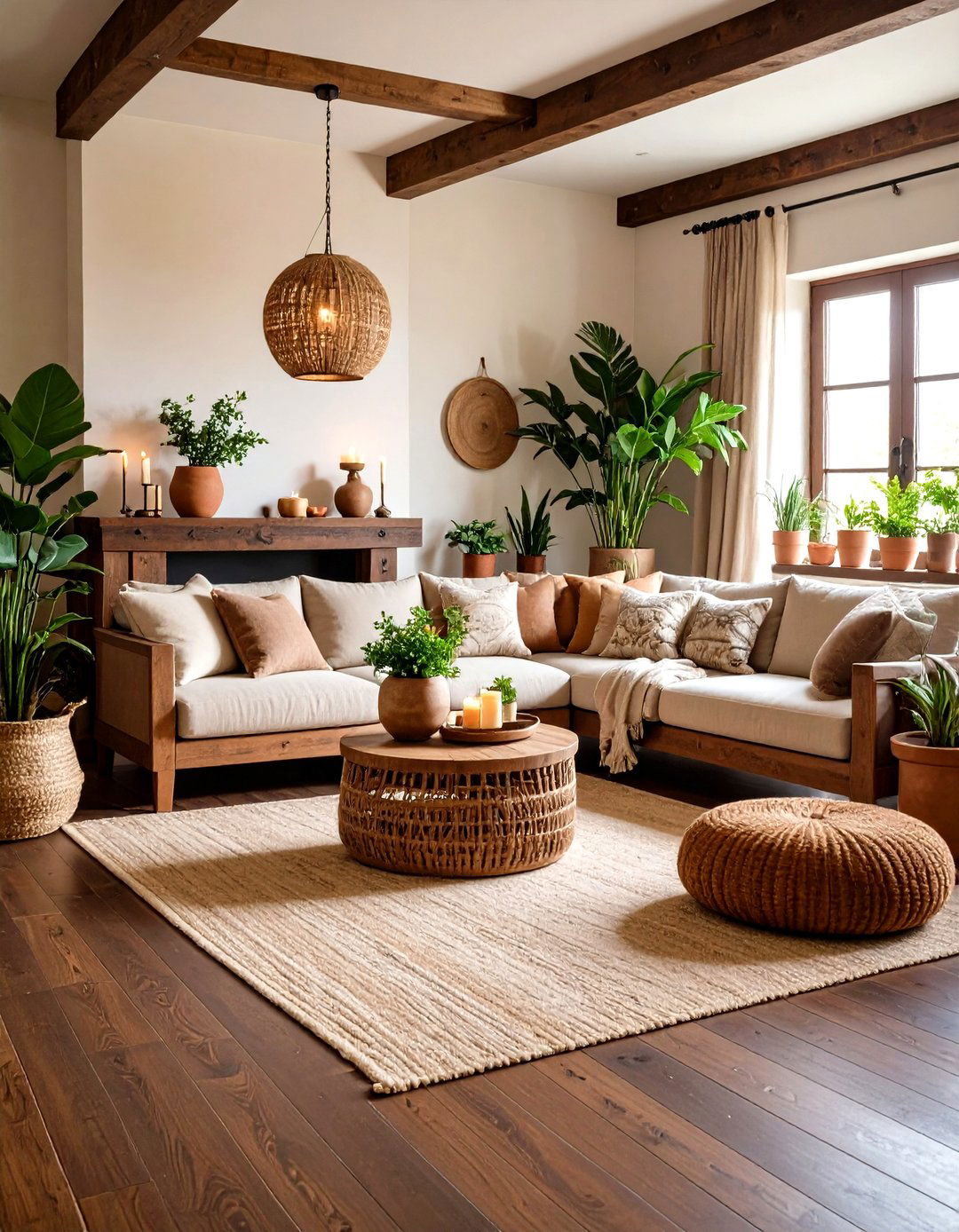
Reclaimed wood mantels, aged brass candlesticks, and slouchy linen cushions introduce patinated surfaces that echo the authenticity of dark hardwood. Designers highlight the warmth such textures lend, noting that they celebrate imperfections rather than masking them. Layer in thriving plants—snake plants, fiddle-leaf figs, trailing pothos—to inject life and break up the heavier tones. A simple trick is to repeat the floor’s undertone in terra-cotta pots or rattan planters so the palette feels continuous from ground to canopy.
19. Choose Matte and Low-Sheen Finishes to Reduce Glare
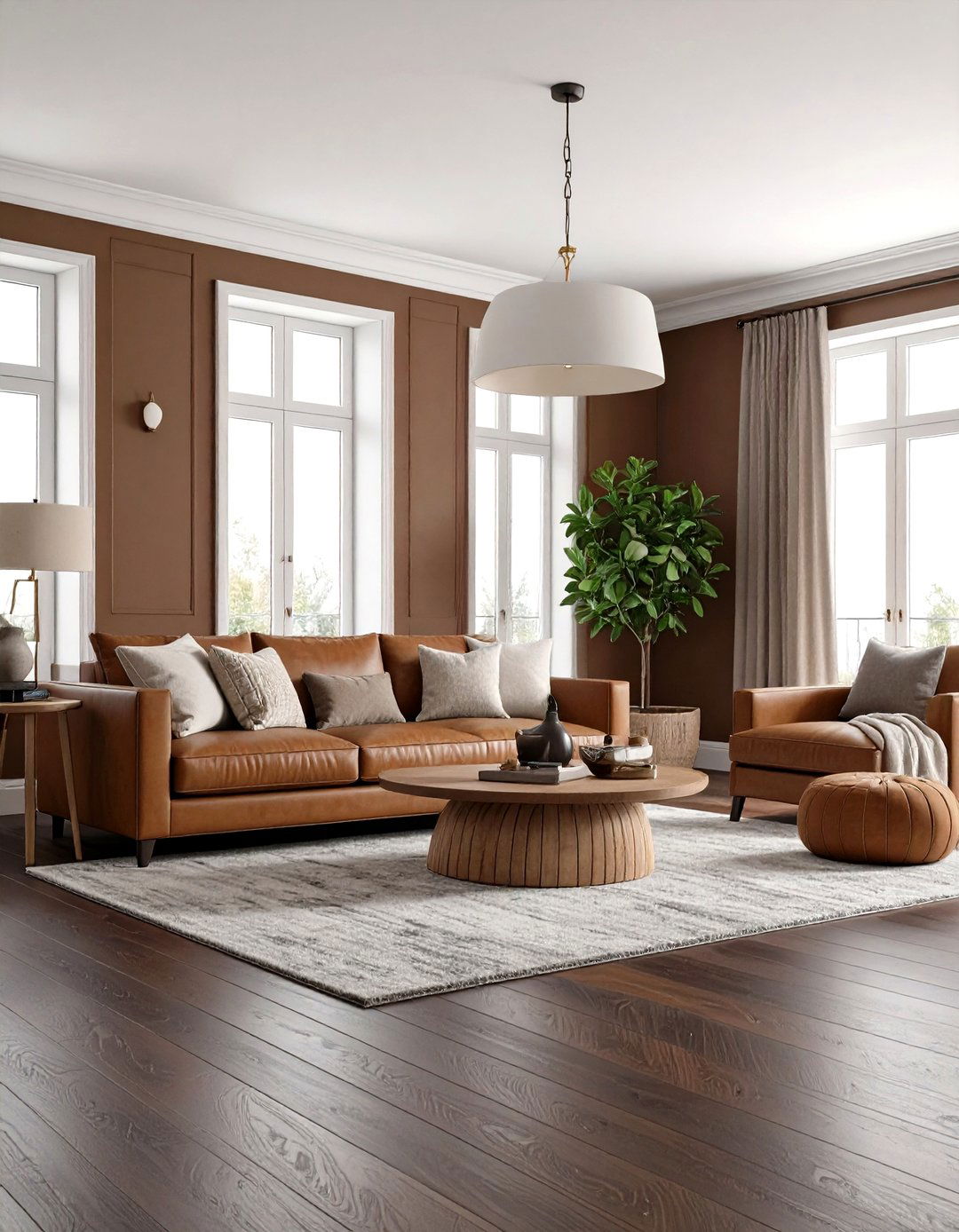
High-gloss surfaces can create unwanted reflections that compete with the subtle luster of a dark brown floor. Interior pros recommend satin or matte paint on walls, furniture with hand-rubbed finishes, and area rugs in dense, non-shiny fibers for a cohesive, glare-free look. The subdued surfaces allow the wood grain’s natural sheen to stand out, while still providing enough light diffusion to keep the room comfortable day or night. As a bonus, lower-sheen finishes hide fingerprints and micro-scratches, making maintenance simpler in busy households.
20. Illuminate Edges with Rail and Recessed Lighting
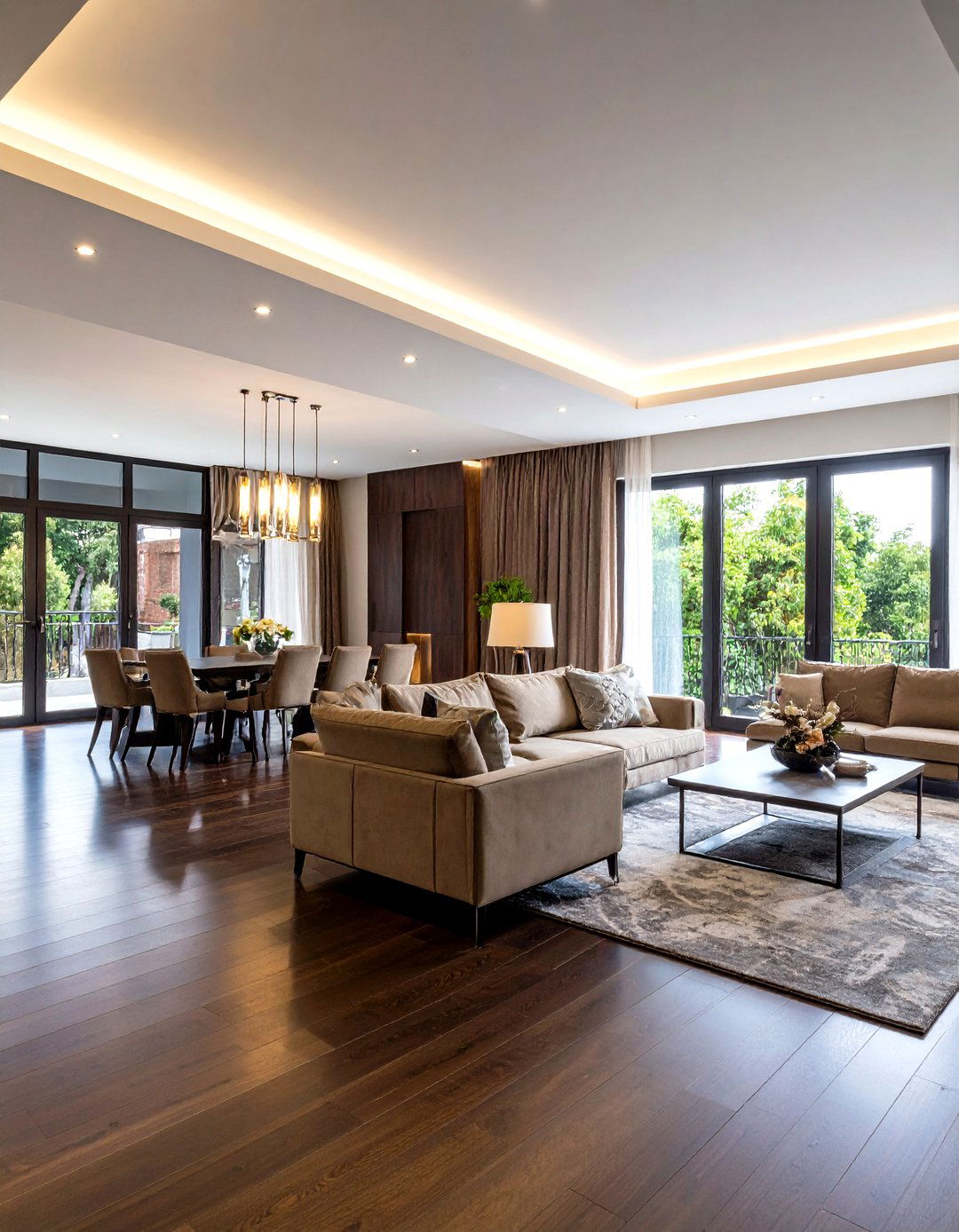
Installing slim rail or recessed LED strips along ceiling coves, baseboards, or within shelving casts an even wash that eliminates the dense shadows often created by dark floors. Pair those practical strips with a statement chandelier or sculptural pendant to satisfy the 2025 emphasis on layered, artistic lighting. Adjustable color temperature lets you shift from cool white for daytime tasks to warm amber for evenings, ensuring the floor’s chocolate undertones remain inviting regardless of the hour.
Conclusion:
Rich brown floors reward thoughtful styling: when you balance light and shadow, weave in texture, and play confidently with proportion, the planks read as a design advantage rather than a constraint. From crisp white walls to sculptural lighting and curved seating, each idea above demonstrates a way to highlight the timber’s depth while tailoring the living room to your lifestyle. Lean on contrast when you need brightness, layer metals and textiles for warmth, and always remember the simple color-ratio rule for effortless cohesion. With these strategies, your dark brown floor becomes an anchor point for a living space that feels timeless, welcoming, and uniquely yours.



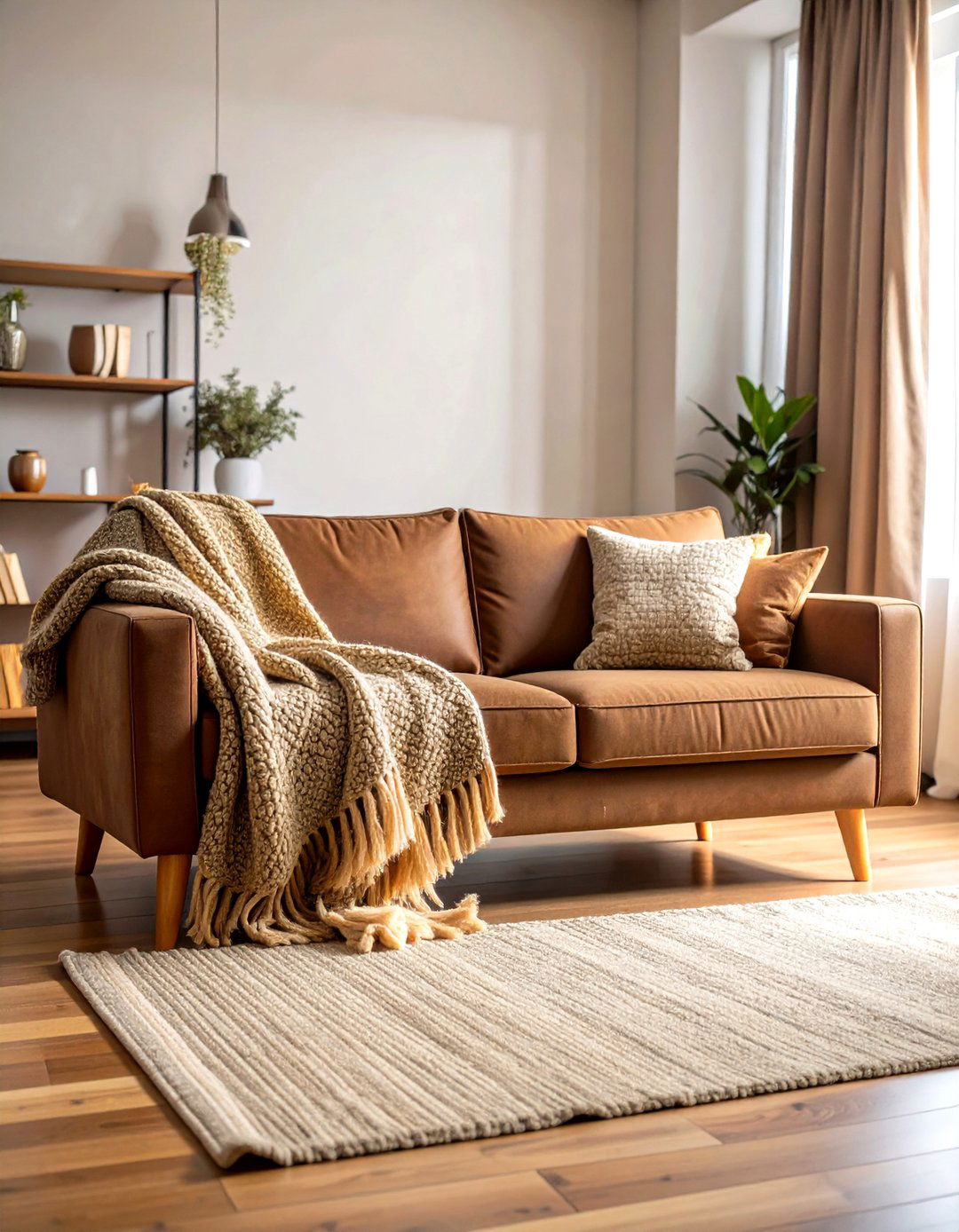
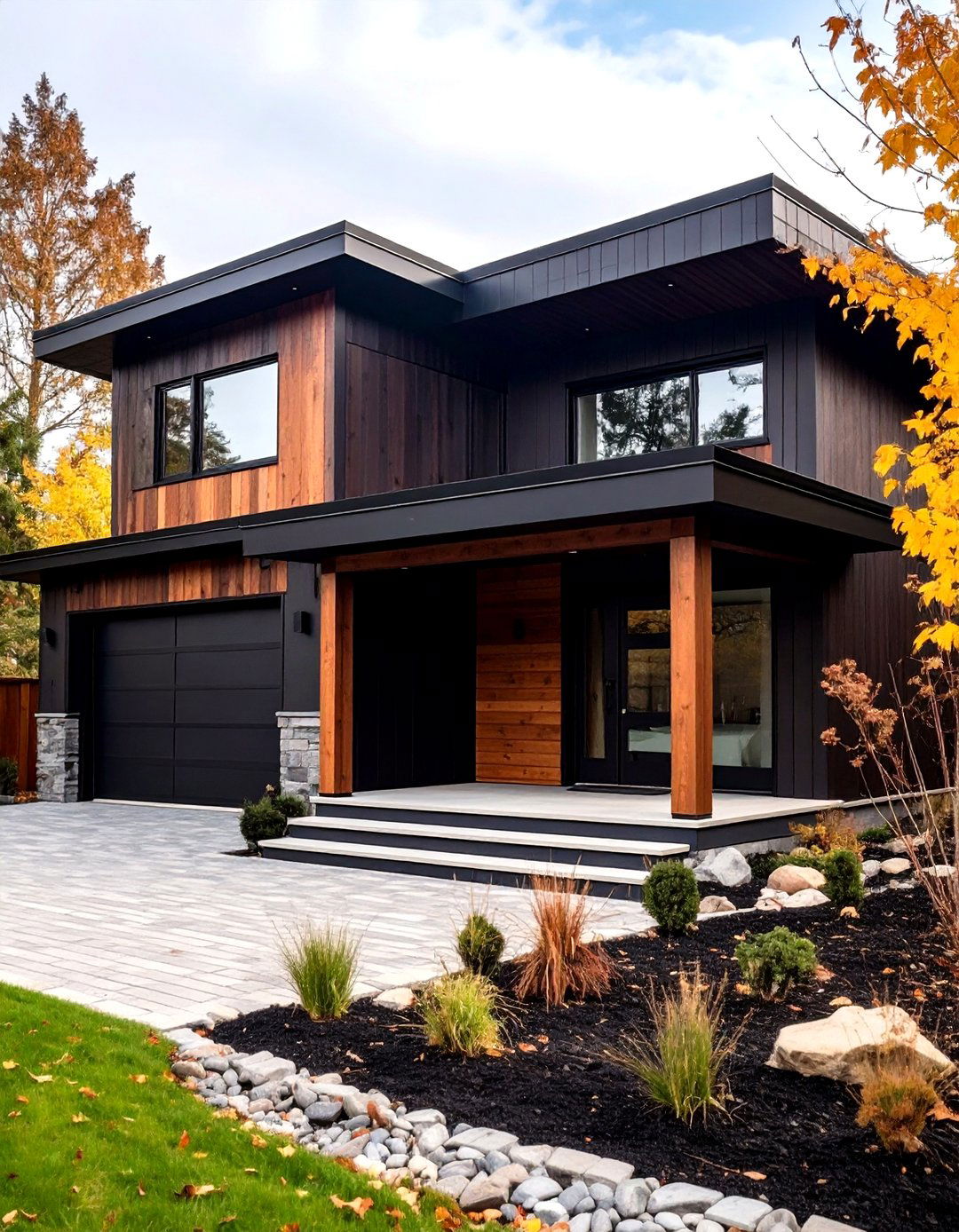

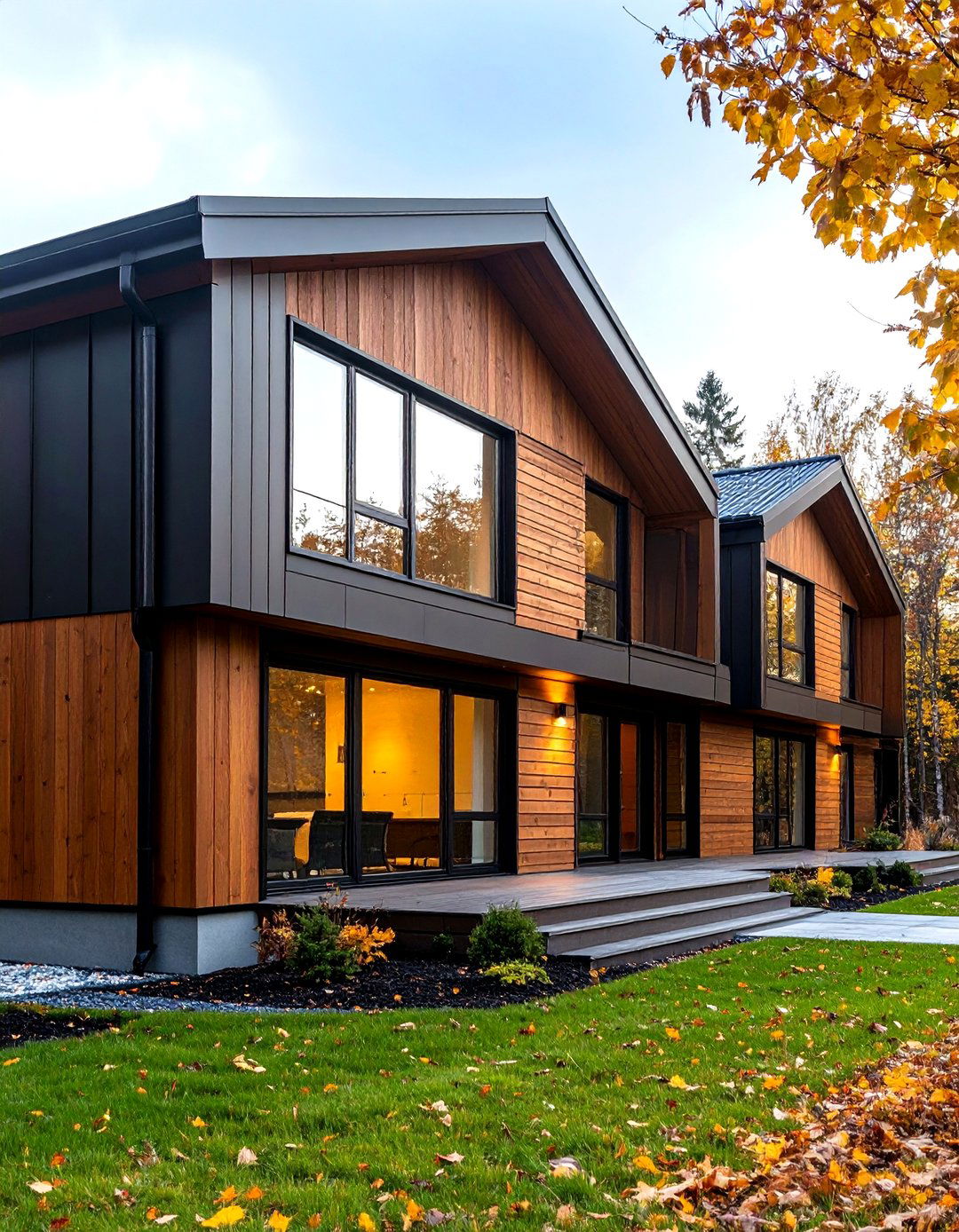
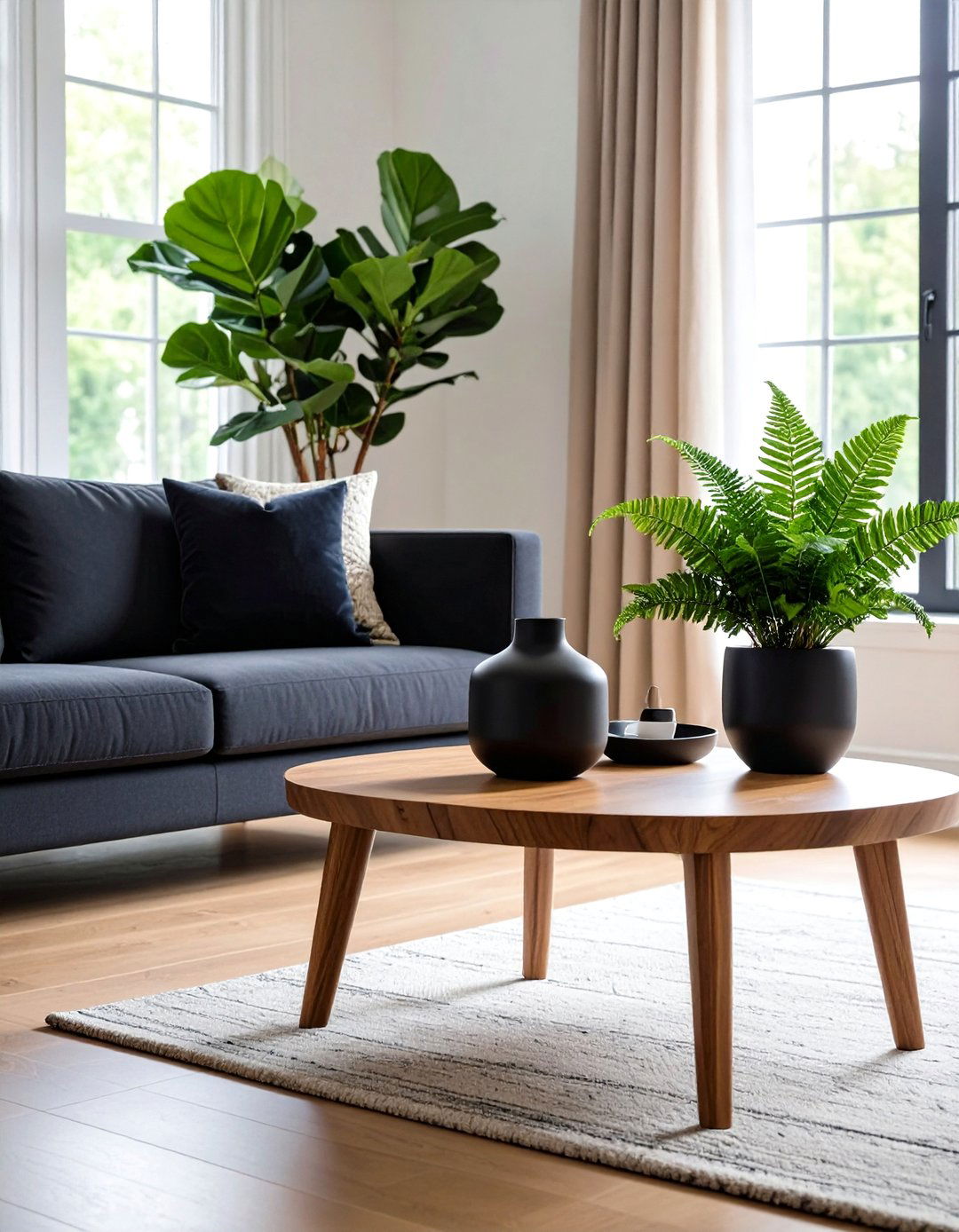
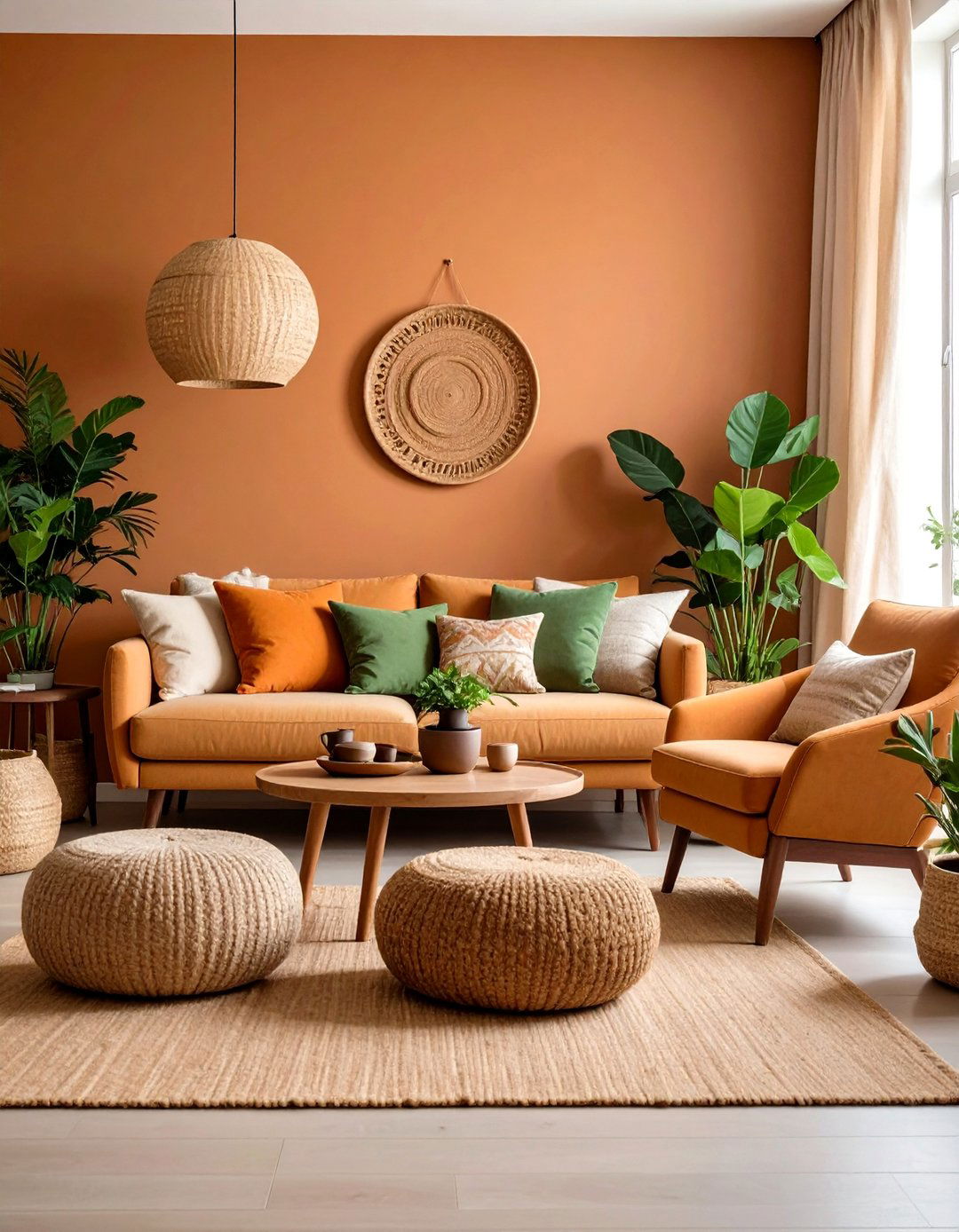
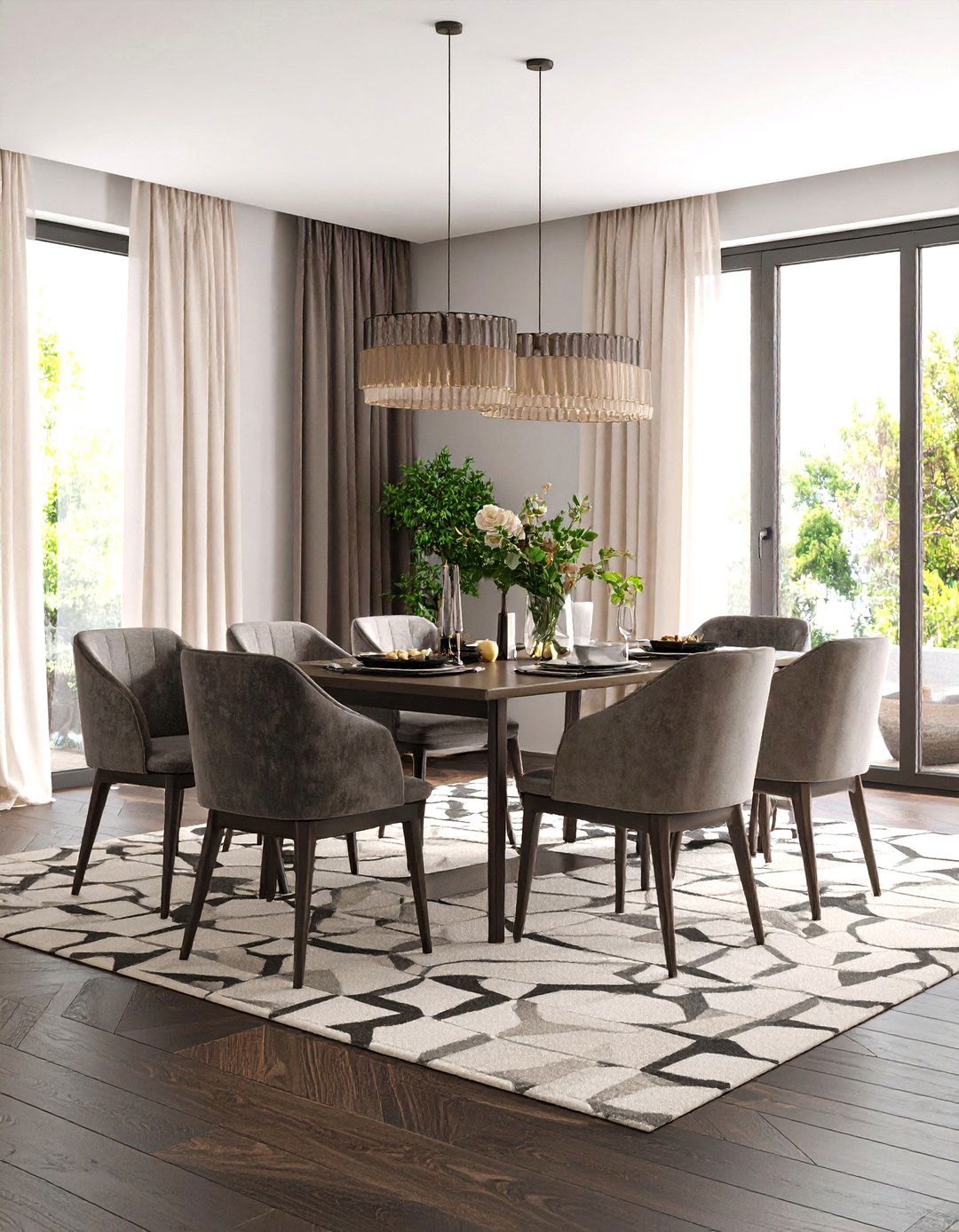
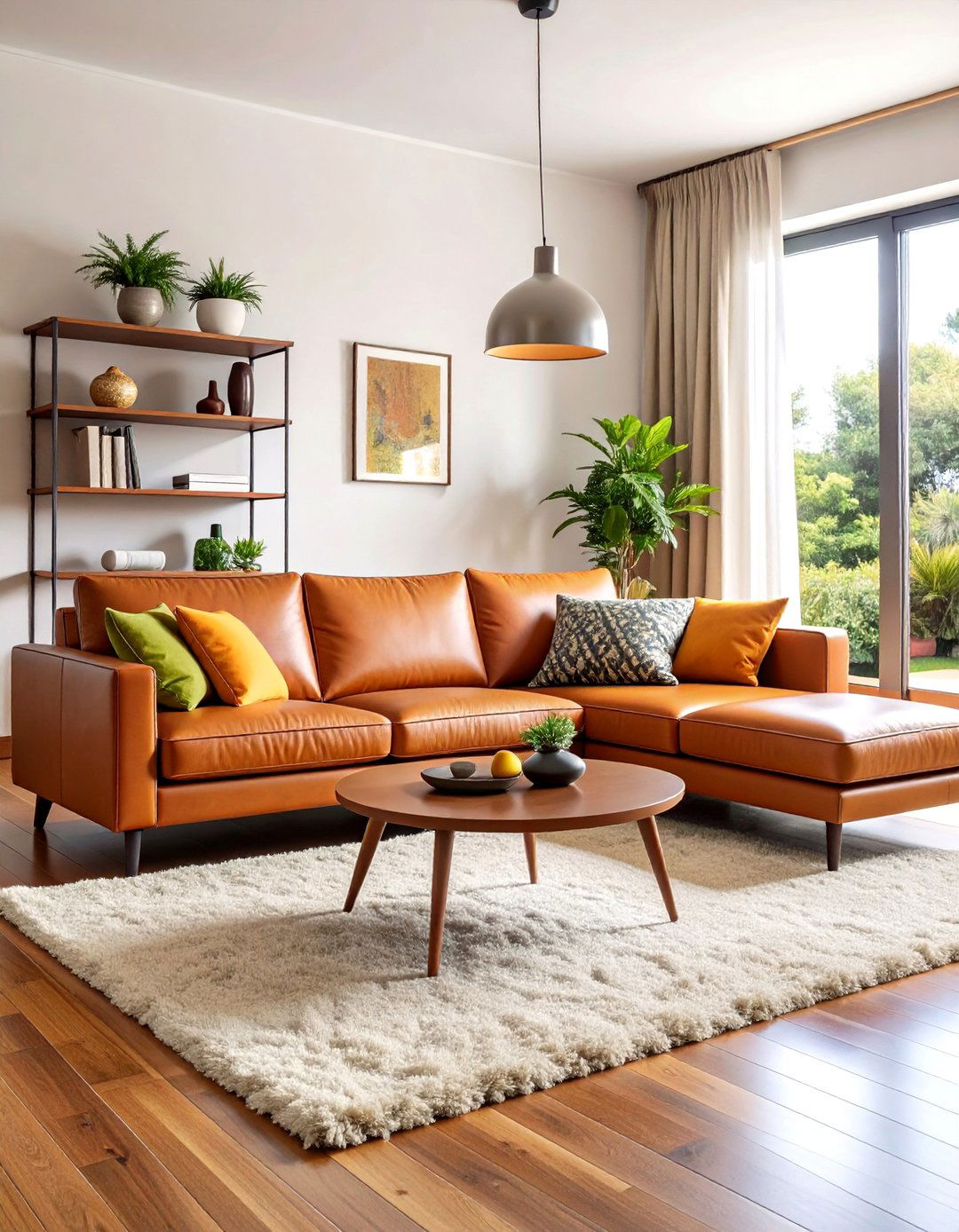
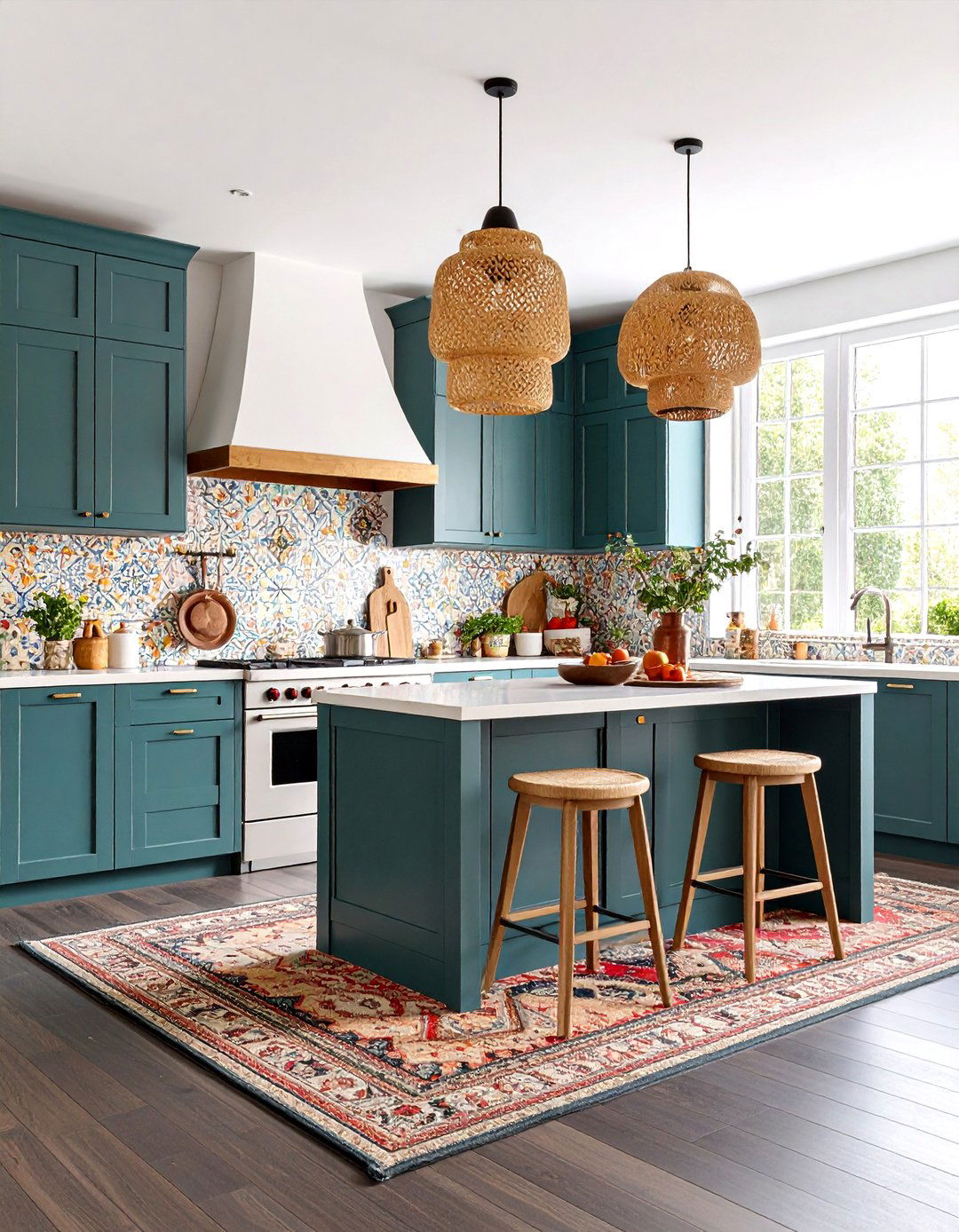
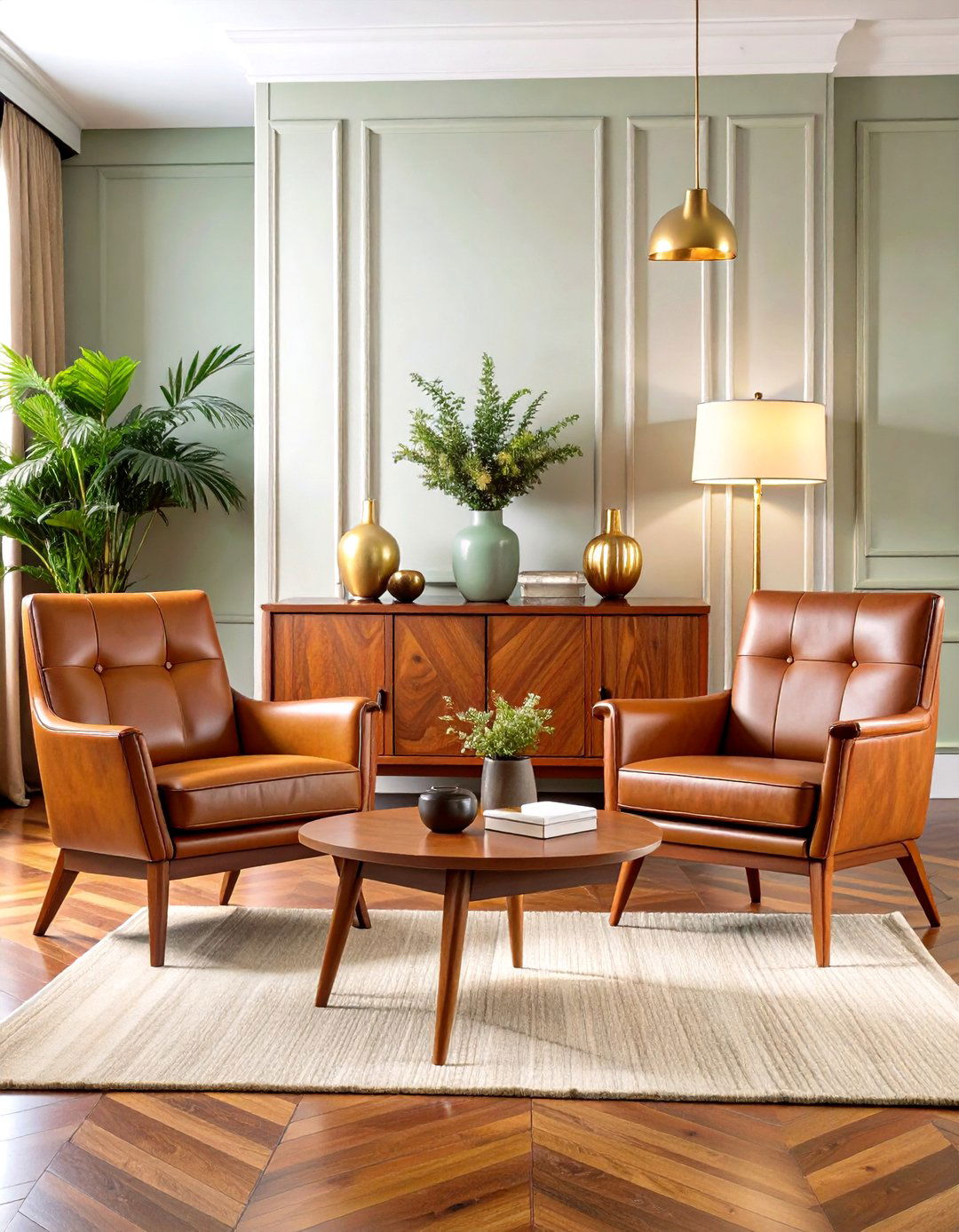
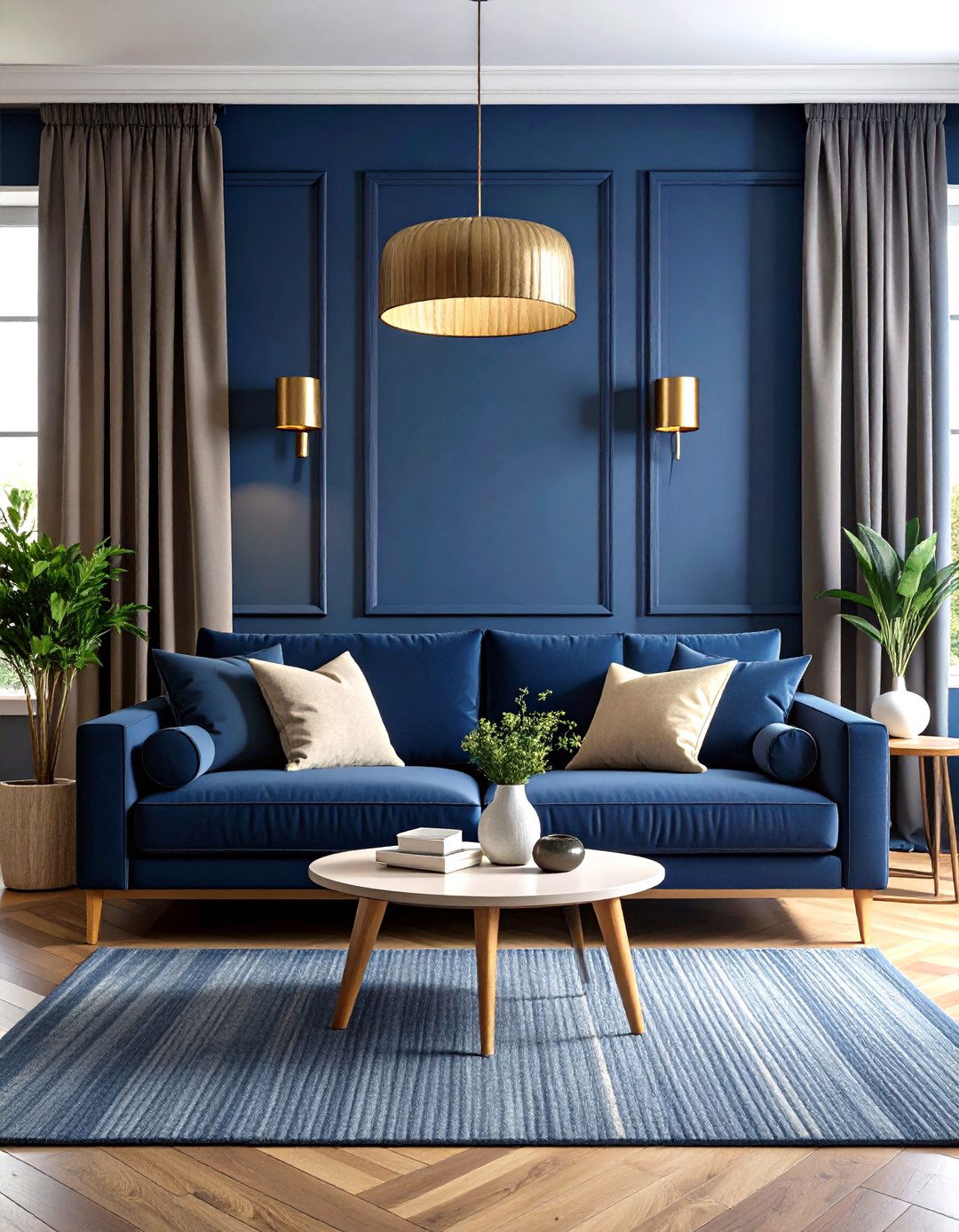
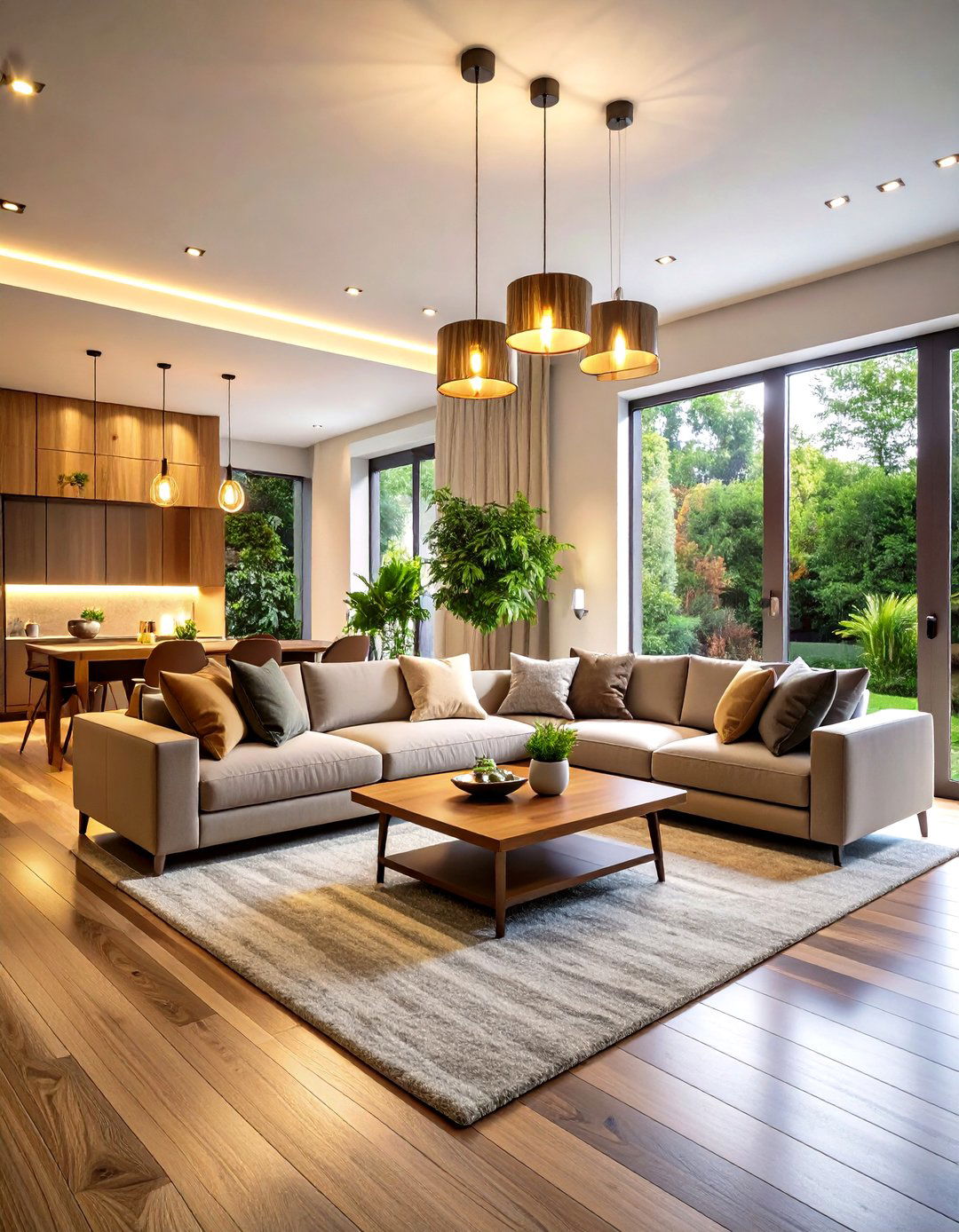
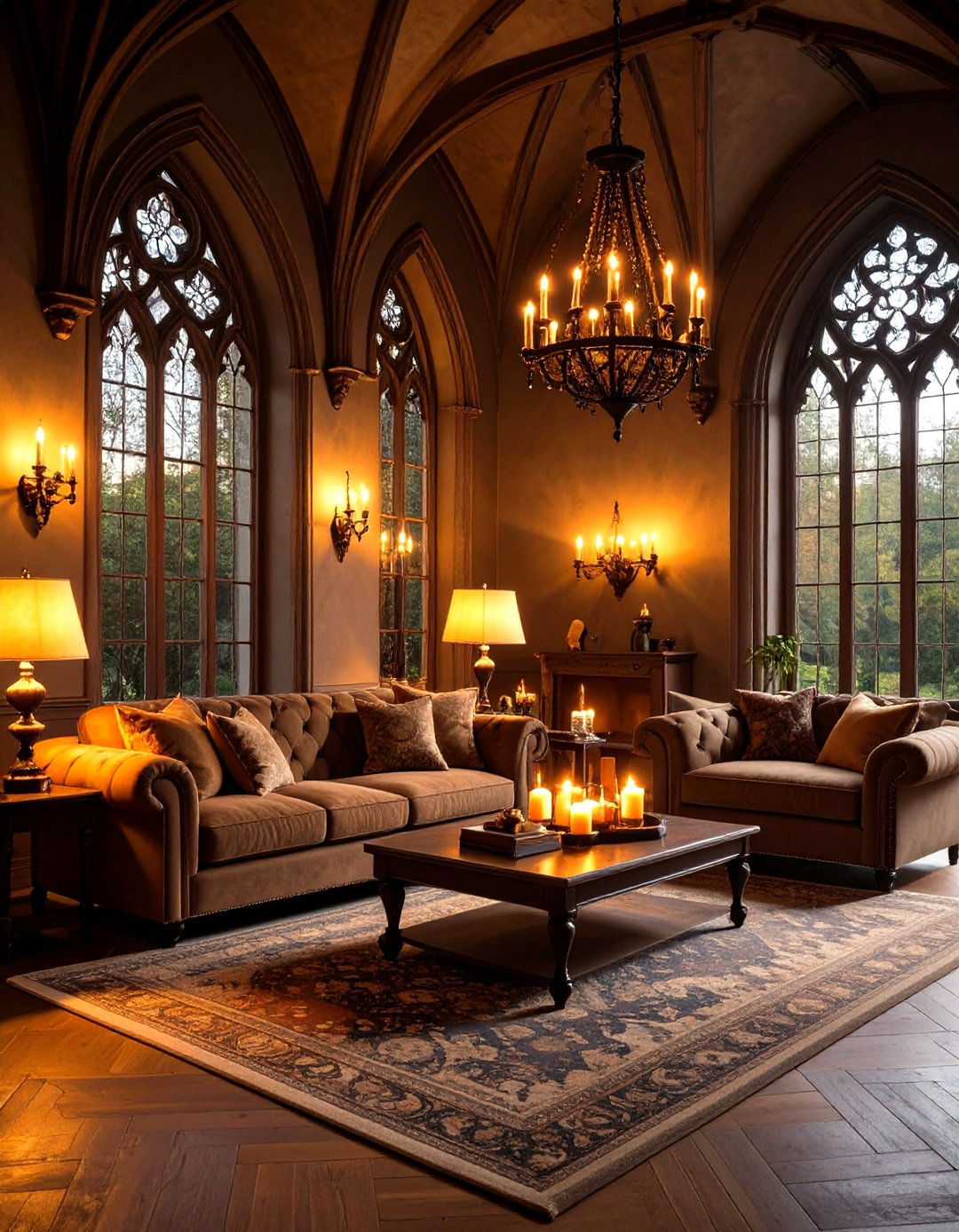

Leave a Reply